
AmCo Holding Company Consolidated Financial Statements with Independent Auditor’s report thereon for the reporting periods ended December 31, 2016 and 2015

Independent Auditor's Report 1 Financial Statements Consolidated Balance Sheets 2 Consolidated Statements of Comprehensive Income 3 Consolidated Statements of Changes in Stockholders' Equity 4 Consolidated Statements of Cash Flows 5 Notes to the Consolidated Financial Statements 6 Contents

Report of Independent Registered Public Accounting Firm To the Board of Directors AmCo Holding Company We have audited the accompanying consolidated balance sheets of AmCo Holding Company and Subsidiary (the Company) as of December 31, 2016 and 2015, and the related consolidated statements of comprehensive income, changes in stockholders’ equity, and cash flows for the years then ended. These consolidated financial statements are the responsibility of the Company’s management. Our responsibility is to express an opinion on these consolidated financial statements based on our audits. We conducted our audits in accordance with the standards of the Public Company Accounting Oversight Board (United States). Those standards require that we plan and perform the audits to obtain reasonable assurance about whether the consolidated financial statements are free of material misstatement. An audit includes examining, on a test basis, evidence supporting the amounts and disclosures in the consolidated financial statements. An audit also includes assessing the accounting principles used and significant estimates made by management, as well as evaluating the overall financial statement presentation. We believe that our audits provide a reasonable basis for our opinion. In our opinion, the consolidated financial statements referred to above present fairly, in all material respects, the financial position of AmCo Holding Company and Subsidiary as of December 31, 2016 and 2015, and the results of their operations and their cash flows for the years then ended in conformity with accounting principles generally accepted in the United States of America. Omaha, Nebraska May 18, 2017
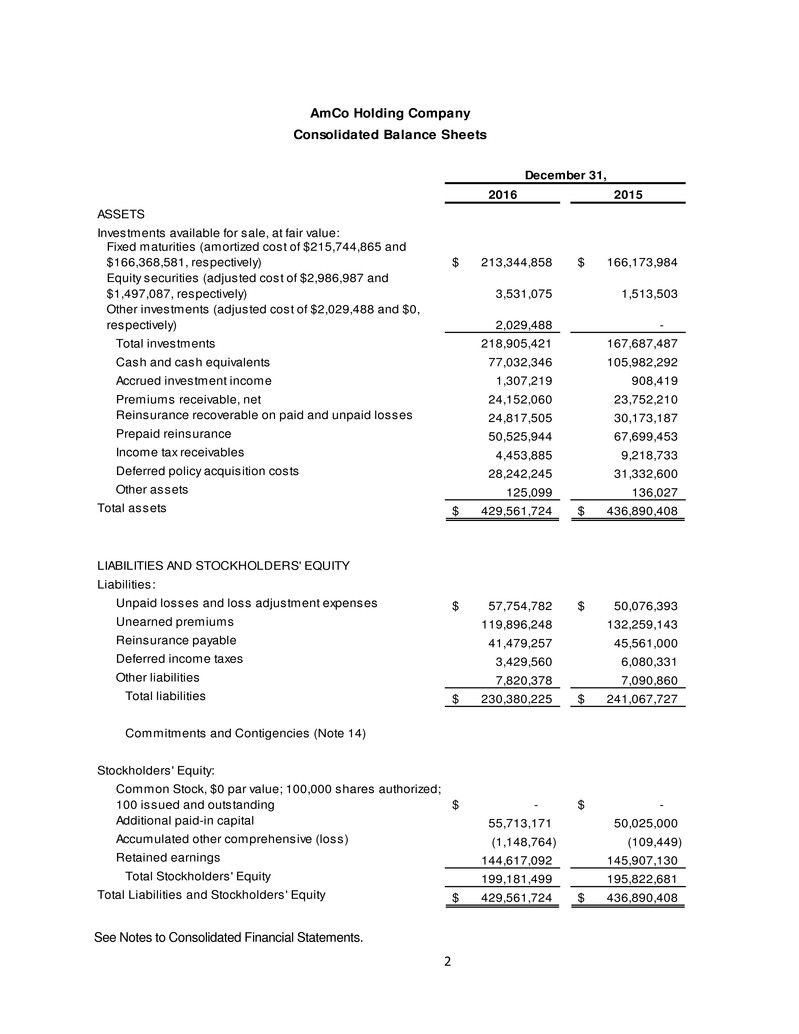
2 2016 2015 ASSETS Investments available for sale, at fair value: Fixed maturities (amortized cost of $215,744,865 and $166,368,581, respectively) 213,344,858$ 166,173,984$ Equity securities (adjusted cost of $2,986,987 and $1,497,087, respectively) 3,531,075 1,513,503 Other investments (adjusted cost of $2,029,488 and $0, respectively) 2,029,488 - Total investments 218,905,421 167,687,487 Cash and cash equivalents 77,032,346 105,982,292 Accrued investment income 1,307,219 908,419 Premiums receivable, net 24,152,060 23,752,210 Reinsurance recoverable on paid and unpaid losses 24,817,505 30,173,187 Prepaid reinsurance 50,525,944 67,699,453 Income tax receivables 4,453,885 9,218,733 Deferred policy acquisition costs 28,242,245 31,332,600 Other assets 125,099 136,027 Total assets 429,561,724$ 436,890,408$ LIABILITIES AND STOCKHOLDERS' EQUITY Liabilities: Unpaid losses and loss adjustment expenses 57,754,782$ 50,076,393$ Unearned premiums 119,896,248 132,259,143 Reinsurance payable 41,479,257 45,561,000 Deferred income taxes 3,429,560 6,080,331 Other liabilities 7,820,378 7,090,860 Total liabilities 230,380,225$ 241,067,727$ Commitments and Contigencies (Note 14) Stockholders' Equity: Common Stock, $0 par value; 100,000 shares authorized; 100 issued and outstanding -$ -$ Additional paid-in capital 55,713,171 50,025,000 Accumulated other comprehensive (loss) (1,148,764) (109,449) Retained earnings 144,617,092 145,907,130 Total Stockholders' Equity 199,181,499 195,822,681 Total Liabilities and Stockholders' Equity 429,561,724$ 436,890,408$ December 31, Consolidated Balance Sheets AmCo Holding Company See Notes to Consolidated Financial Statements.
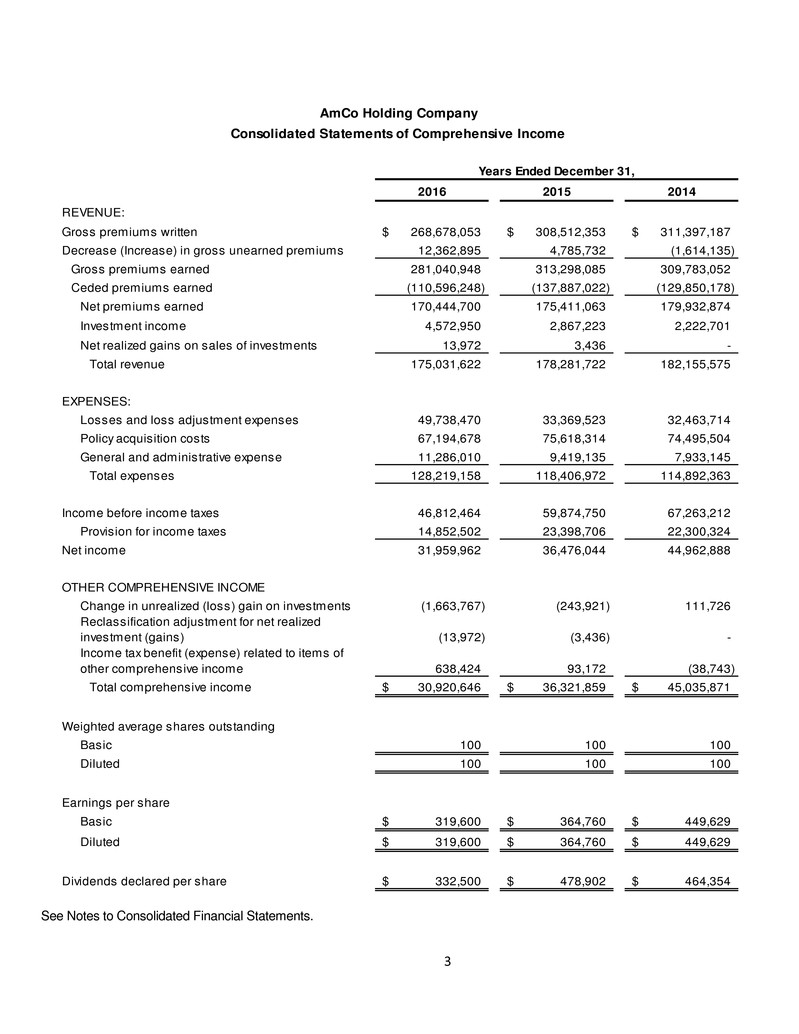
3 2016 2015 2014 REVENUE: Gross premiums written 268,678,053$ 308,512,353$ 311,397,187$ Decrease (Increase) in gross unearned premiums 12,362,895 4,785,732 (1,614,135) Gross premiums earned 281,040,948 313,298,085 309,783,052 Ceded premiums earned (110,596,248) (137,887,022) (129,850,178) Net premiums earned 170,444,700 175,411,063 179,932,874 Investment income 4,572,950 2,867,223 2,222,701 Net realized gains on sales of investments 13,972 3,436 - Total revenue 175,031,622 178,281,722 182,155,575 EXPENSES: Losses and loss adjustment expenses 49,738,470 33,369,523 32,463,714 Policy acquisition costs 67,194,678 75,618,314 74,495,504 General and administrative expense 11,286,010 9,419,135 7,933,145 Total expenses 128,219,158 118,406,972 114,892,363 Income before income taxes 46,812,464 59,874,750 67,263,212 Provision for income taxes 14,852,502 23,398,706 22,300,324 Net income 31,959,962 36,476,044 44,962,888 OTHER COMPREHENSIVE INCOME Change in unrealized (loss) gain on investments (1,663,767) (243,921) 111,726 Reclassification adjustment for net realized investment (gains) (13,972) (3,436) - Income tax benefit (expense) related to items of other comprehensive income 638,424 93,172 (38,743) Total comprehensive income 30,920,646$ 36,321,859$ 45,035,871$ Weighted average shares outstanding Basic 100 100 100 Diluted 100 100 100 Earnings per share Basic 319,600$ 364,760$ 449,629$ Diluted 319,600$ 364,760$ 449,629$ Dividends declared per share 332,500$ 478,902$ 464,354$ Years Ended December 31, AmCo Holding Company Consolidated Statements of Comprehensive Income See Notes to Consolidated Financial Statements.
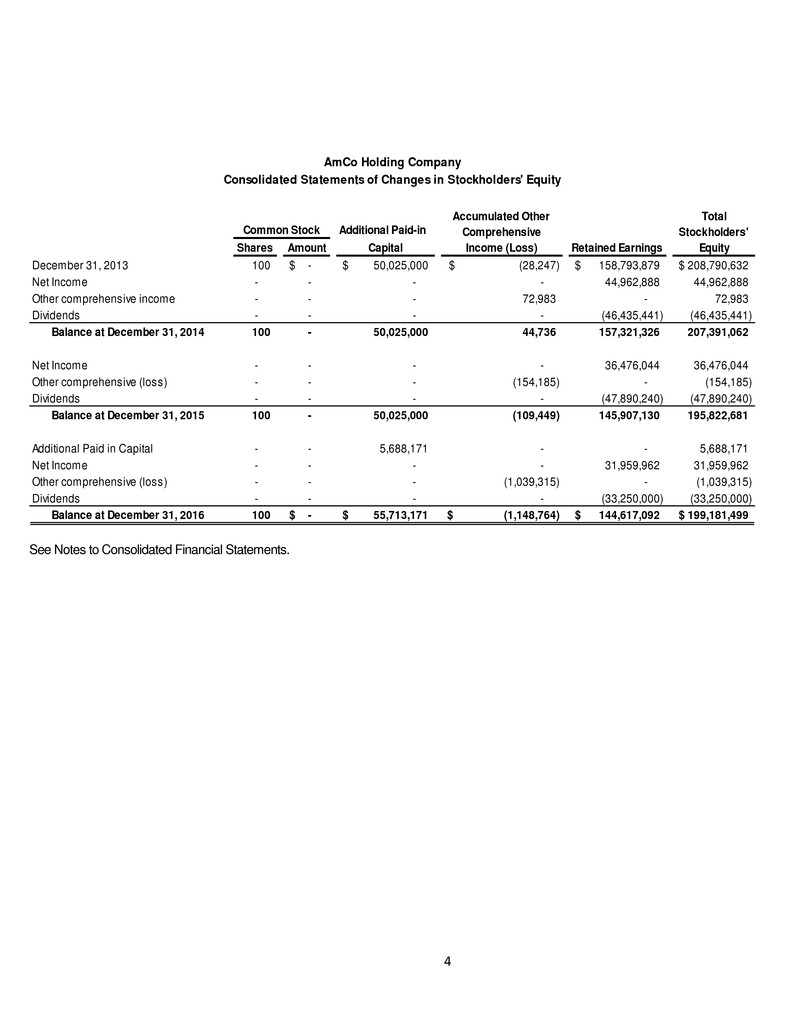
4 Additional Paid-in Shares Amount Capital December 31, 2013 100 -$ 50,025,000$ (28,247)$ 158,793,879$ 208,790,632$ Net Income - - - - 44,962,888 44,962,888 Other comprehensive income - - - 72,983 - 72,983 Dividends - - - - (46,435,441) (46,435,441) Balance at December 31, 2014 100 - 50,025,000 44,736 157,321,326 207,391,062 Net Income - - - - 36,476,044 36,476,044 Other comprehensive (loss) - - - (154,185) - (154,185) Dividends - - - - (47,890,240) (47,890,240) Balance at December 31, 2015 100 - 50,025,000 (109,449) 145,907,130 195,822,681 Additional Paid in Capital - - 5,688,171 - - 5,688,171 Net Income - - - - 31,959,962 31,959,962 Other comprehensive (loss) - - - (1,039,315) - (1,039,315) Dividends - - - - (33,250,000) (33,250,000) Balance at December 31, 2016 100 -$ 55,713,171$ (1,148,764)$ 144,617,092$ 199,181,499$ Common Stock Accumulated Other Comprehensive Income (Loss) Total Stockholders' EquityRetained Earnings AmCo Holding Company Consolidated Statements of Changes in Stockholders' Equity See Notes to Consolidated Financial Statements.
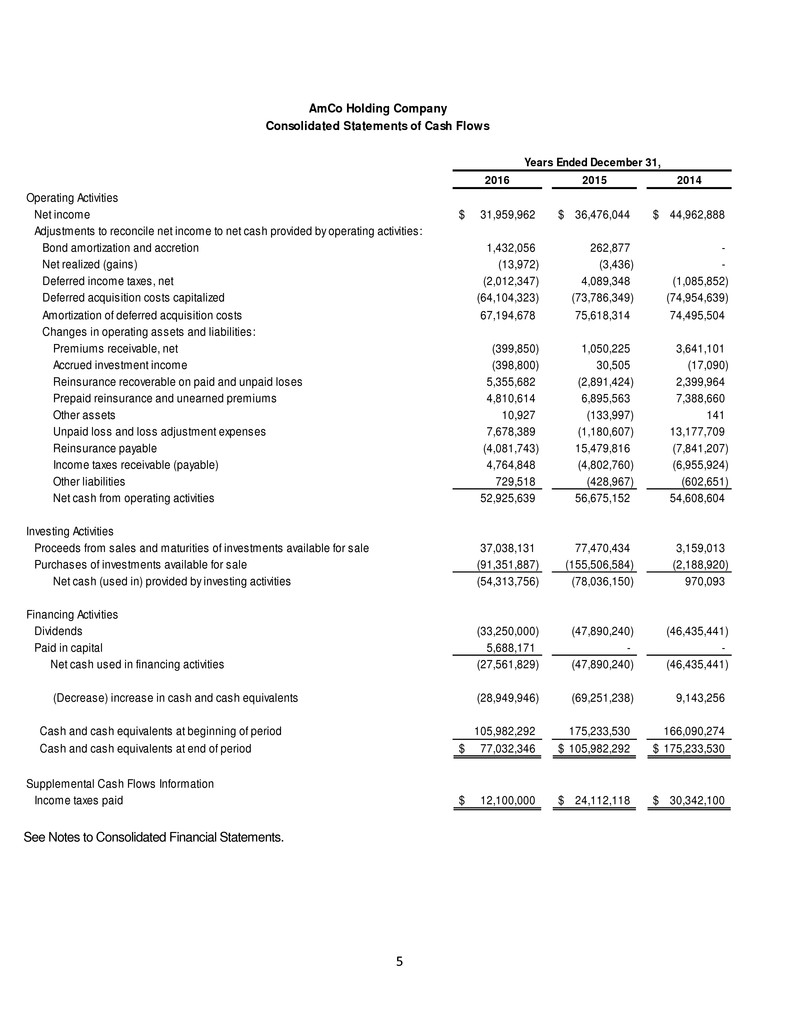
5 2016 2015 2014 Operating Activities Net income 31,959,962$ 36,476,044$ 44,962,888$ Adjustments to reconcile net income to net cash provided by operating activities: Bond amortization and accretion 1,432,056 262,877 - Net realized (gains) (13,972) (3,436) - Deferred income taxes, net (2,012,347) 4,089,348 (1,085,852) Deferred acquisition costs capitalized (64,104,323) (73,786,349) (74,954,639) Amortization of deferred acquisition costs 67,194,678 75,618,314 74,495,504 Changes in operating assets and liabilities: Premiums receivable, net (399,850) 1,050,225 3,641,101 Accrued investment income (398,800) 30,505 (17,090) Reinsurance recoverable on paid and unpaid loses 5,355,682 (2,891,424) 2,399,964 Prepaid reinsurance and unearned premiums 4,810,614 6,895,563 7,388,660 Other assets 10,927 (133,997) 141 Unpaid loss and loss adjustment expenses 7,678,389 (1,180,607) 13,177,709 Reinsurance payable (4,081,743) 15,479,816 (7,841,207) Income taxes receivable (payable) 4,764,848 (4,802,760) (6,955,924) Other liabilities 729,518 (428,967) (602,651) Net cash from operating activities 52,925,639 56,675,152 54,608,604 Investing Activities Proceeds from sales and maturities of investments available for sale 37,038,131 77,470,434 3,159,013 Purchases of investments available for sale (91,351,887) (155,506,584) (2,188,920) Net cash (used in) provided by investing activities (54,313,756) (78,036,150) 970,093 Financing Activities Dividends (33,250,000) (47,890,240) (46,435,441) Paid in capital 5,688,171 - - Net cash used in financing activities (27,561,829) (47,890,240) (46,435,441) (Decrease) increase in cash and cash equivalents (28,949,946) (69,251,238) 9,143,256 Cash and cash equivalents at beginning of period 105,982,292 175,233,530 166,090,274 Cash and cash equivalents at end of period 77,032,346$ 105,982,292$ 175,233,530$ Supplemental Cash Flows Information Income taxes paid 12,100,000$ 24,112,118$ 30,342,100$ AmCo Holding Company Consolidated Statements of Cash Flows Years Ended December 31, See Notes to Consolidated Financial Statements.
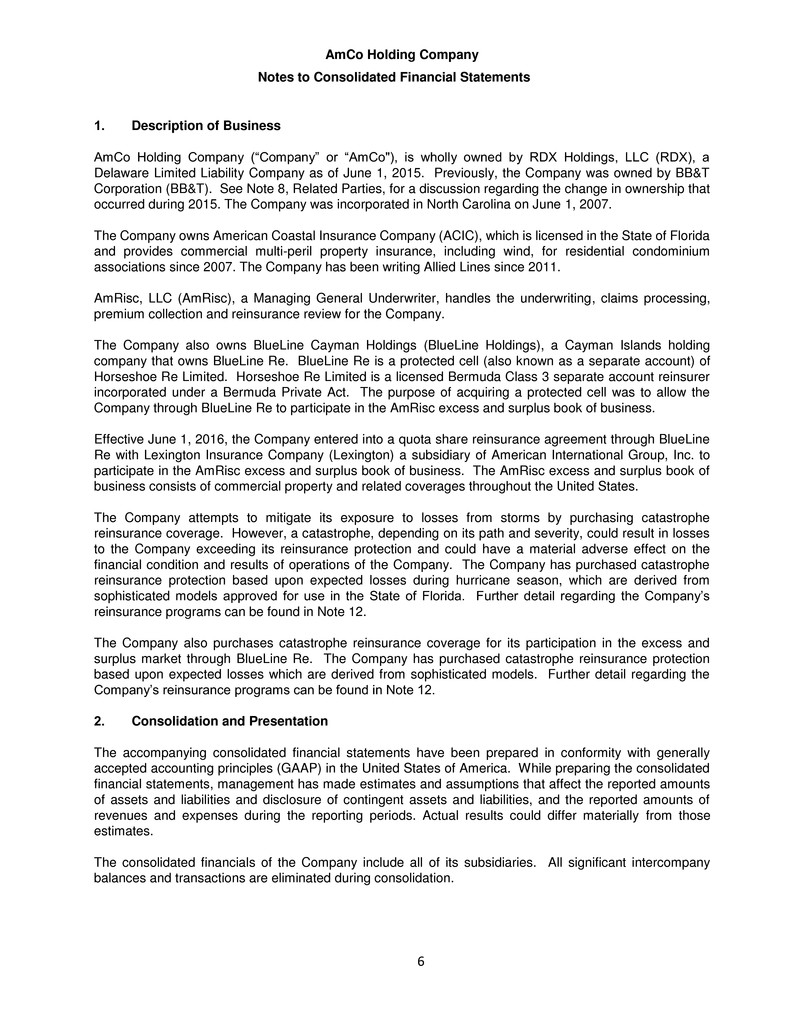
AmCo Holding Company Notes to Consolidated Financial Statements 6 1. Description of Business AmCo Holding Company (“Company” or “AmCo"), is wholly owned by RDX Holdings, LLC (RDX), a Delaware Limited Liability Company as of June 1, 2015. Previously, the Company was owned by BB&T Corporation (BB&T). See Note 8, Related Parties, for a discussion regarding the change in ownership that occurred during 2015. The Company was incorporated in North Carolina on June 1, 2007. The Company owns American Coastal Insurance Company (ACIC), which is licensed in the State of Florida and provides commercial multi-peril property insurance, including wind, for residential condominium associations since 2007. The Company has been writing Allied Lines since 2011. AmRisc, LLC (AmRisc), a Managing General Underwriter, handles the underwriting, claims processing, premium collection and reinsurance review for the Company. The Company also owns BlueLine Cayman Holdings (BlueLine Holdings), a Cayman Islands holding company that owns BlueLine Re. BlueLine Re is a protected cell (also known as a separate account) of Horseshoe Re Limited. Horseshoe Re Limited is a licensed Bermuda Class 3 separate account reinsurer incorporated under a Bermuda Private Act. The purpose of acquiring a protected cell was to allow the Company through BlueLine Re to participate in the AmRisc excess and surplus book of business. Effective June 1, 2016, the Company entered into a quota share reinsurance agreement through BlueLine Re with Lexington Insurance Company (Lexington) a subsidiary of American International Group, Inc. to participate in the AmRisc excess and surplus book of business. The AmRisc excess and surplus book of business consists of commercial property and related coverages throughout the United States. The Company attempts to mitigate its exposure to losses from storms by purchasing catastrophe reinsurance coverage. However, a catastrophe, depending on its path and severity, could result in losses to the Company exceeding its reinsurance protection and could have a material adverse effect on the financial condition and results of operations of the Company. The Company has purchased catastrophe reinsurance protection based upon expected losses during hurricane season, which are derived from sophisticated models approved for use in the State of Florida. Further detail regarding the Company’s reinsurance programs can be found in Note 12. The Company also purchases catastrophe reinsurance coverage for its participation in the excess and surplus market through BlueLine Re. The Company has purchased catastrophe reinsurance protection based upon expected losses which are derived from sophisticated models. Further detail regarding the Company’s reinsurance programs can be found in Note 12. 2. Consolidation and Presentation The accompanying consolidated financial statements have been prepared in conformity with generally accepted accounting principles (GAAP) in the United States of America. While preparing the consolidated financial statements, management has made estimates and assumptions that affect the reported amounts of assets and liabilities and disclosure of contingent assets and liabilities, and the reported amounts of revenues and expenses during the reporting periods. Actual results could differ materially from those estimates. The consolidated financials of the Company include all of its subsidiaries. All significant intercompany balances and transactions are eliminated during consolidation.
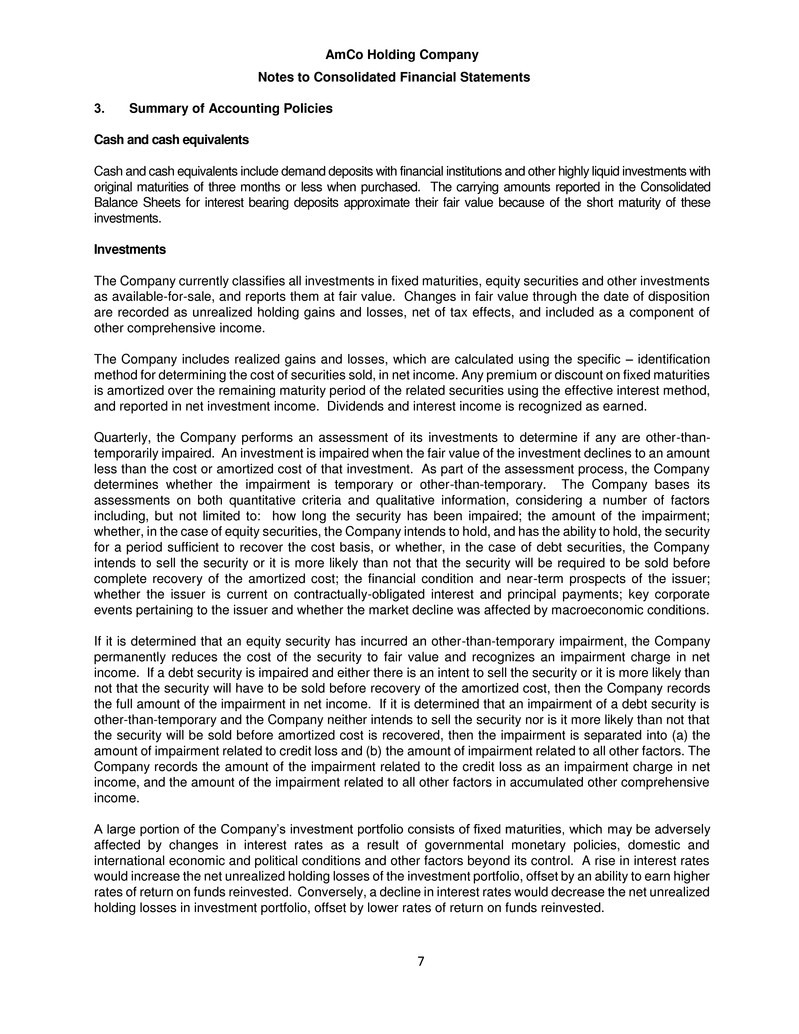
AmCo Holding Company Notes to Consolidated Financial Statements 7 3. Summary of Accounting Policies Cash and cash equivalents Cash and cash equivalents include demand deposits with financial institutions and other highly liquid investments with original maturities of three months or less when purchased. The carrying amounts reported in the Consolidated Balance Sheets for interest bearing deposits approximate their fair value because of the short maturity of these investments. Investments The Company currently classifies all investments in fixed maturities, equity securities and other investments as available-for-sale, and reports them at fair value. Changes in fair value through the date of disposition are recorded as unrealized holding gains and losses, net of tax effects, and included as a component of other comprehensive income. The Company includes realized gains and losses, which are calculated using the specific – identification method for determining the cost of securities sold, in net income. Any premium or discount on fixed maturities is amortized over the remaining maturity period of the related securities using the effective interest method, and reported in net investment income. Dividends and interest income is recognized as earned. Quarterly, the Company performs an assessment of its investments to determine if any are other-than- temporarily impaired. An investment is impaired when the fair value of the investment declines to an amount less than the cost or amortized cost of that investment. As part of the assessment process, the Company determines whether the impairment is temporary or other-than-temporary. The Company bases its assessments on both quantitative criteria and qualitative information, considering a number of factors including, but not limited to: how long the security has been impaired; the amount of the impairment; whether, in the case of equity securities, the Company intends to hold, and has the ability to hold, the security for a period sufficient to recover the cost basis, or whether, in the case of debt securities, the Company intends to sell the security or it is more likely than not that the security will be required to be sold before complete recovery of the amortized cost; the financial condition and near-term prospects of the issuer; whether the issuer is current on contractually-obligated interest and principal payments; key corporate events pertaining to the issuer and whether the market decline was affected by macroeconomic conditions. If it is determined that an equity security has incurred an other-than-temporary impairment, the Company permanently reduces the cost of the security to fair value and recognizes an impairment charge in net income. If a debt security is impaired and either there is an intent to sell the security or it is more likely than not that the security will have to be sold before recovery of the amortized cost, then the Company records the full amount of the impairment in net income. If it is determined that an impairment of a debt security is other-than-temporary and the Company neither intends to sell the security nor is it more likely than not that the security will be sold before amortized cost is recovered, then the impairment is separated into (a) the amount of impairment related to credit loss and (b) the amount of impairment related to all other factors. The Company records the amount of the impairment related to the credit loss as an impairment charge in net income, and the amount of the impairment related to all other factors in accumulated other comprehensive income. A large portion of the Company’s investment portfolio consists of fixed maturities, which may be adversely affected by changes in interest rates as a result of governmental monetary policies, domestic and international economic and political conditions and other factors beyond its control. A rise in interest rates would increase the net unrealized holding losses of the investment portfolio, offset by an ability to earn higher rates of return on funds reinvested. Conversely, a decline in interest rates would decrease the net unrealized holding losses in investment portfolio, offset by lower rates of return on funds reinvested.

AmCo Holding Company Notes to Consolidated Financial Statements 8 Premiums Premiums are recorded as earned on a daily pro rata basis over the contract period that the related policies are expected to be in force. All premiums are collected by AmRisc and remitted to the Company weekly. The portion of premiums not earned at the end of the year is recorded as unearned premiums. Premiums receivable are recorded when written premiums are recorded and are net of any commissions or fees due to the managing general agent or producer. The Company performs a policy-level evaluation to determine the extent to which the balances of premium receivable exceeds the balance of unearned premium. Premiums receivable is charged to bad debt expense in the period determined uncollectible. Management examines write-offs annually to determine if an allowance account should be established. Recoveries received on amounts previously charged-off are credited to bad debt expense in the period received. No material write-offs were incurred in the years ended December 31, 2016 or 2015. The Company has not recorded an allowance for doubtful accounts as of December 31, 2016 or 2015. Policy Acquisition Costs The Company incurs policy acquisition costs that vary with, and are directly related to, the production of new business. These costs are capitalized to the extent recoverable and amortized over the contract period of the related policies. The Company actively evaluates if a premium deficiency exists. A premium deficiency would result if the sum of the expected losses, deferred acquisition costs, and policy maintenance costs (such as costs to store records and costs incurred to collect premiums and pay commissions) exceeded the related unearned premiums plus investment income. Should a premium deficiency exist, the unrecoverable portion of the deferred acquisition costs would be written off and a liability to the extent of the exceeded deficiency would be recorded. Loss and Loss Adjustment Expenses Reserves The reserve for loss and loss adjustment expense (LAE) reflects the Company’s best estimate for future amounts needed to pay losses and related settlement expenses with respect to insured events. The process of establishing the ultimate claims liability is necessarily a complex and imprecise process, requiring the use of informed estimates and judgments using data currently available. Reserves are recorded on an undiscounted basis. The liability includes an amount determined on the basis of claim adjusters’ evaluations with respect to insured events that have occurred and been reported to the Company and an amount for losses incurred that have not yet been reported to the Company. In some cases, significant periods of time, up to several years or more, may elapse between the occurrence of an insured loss and the reporting of such to the Company. Estimates for unpaid loss and LAE are based on management’s assessment of known facts and circumstances, industry loss ratios and third-party actuarial opinions. These estimates are reviewed regularly and any resulting adjustments are made in the accounting period in which the adjustment arose. The Company reports its reserves for unpaid losses gross of the amounts related to unpaid losses recoverable from reinsurers and reports losses net of amounts ceded to reinsurers. The Company does not discount its loss reserves for financial statement purposes. Reinsurance The Company follows the industry practice of reinsuring a portion of its risks. Reinsurance involves transferring, or "ceding", all or a portion of the risk exposure on policies to another insurer, known as a
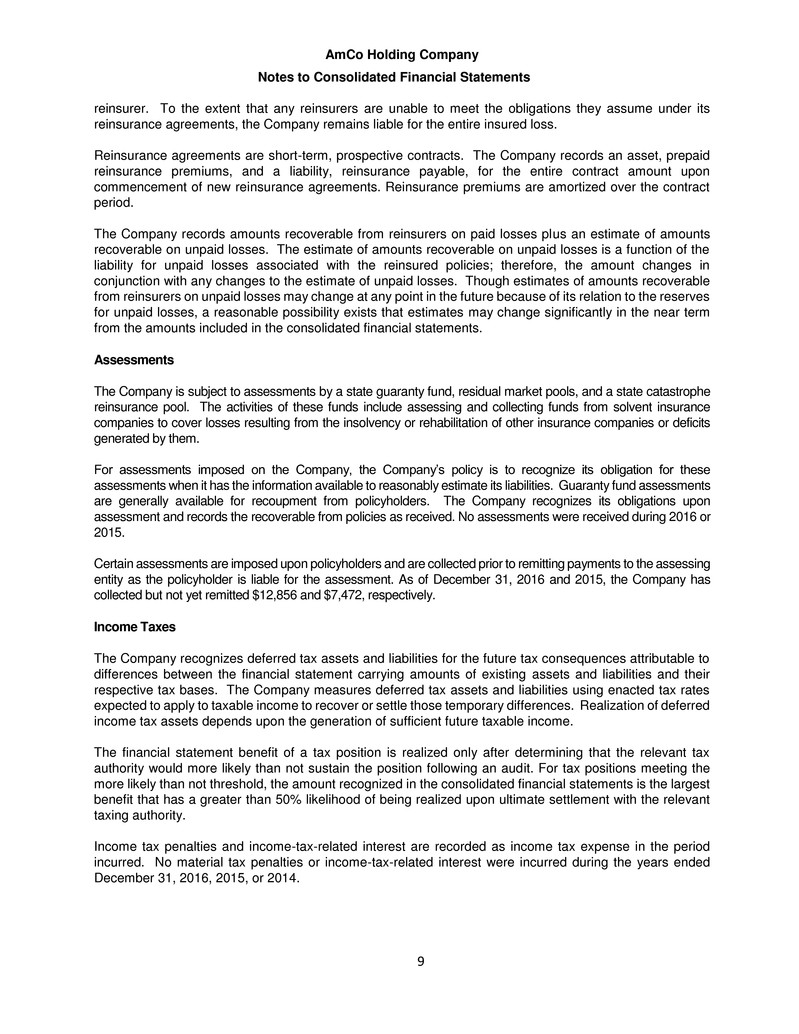
AmCo Holding Company Notes to Consolidated Financial Statements 9 reinsurer. To the extent that any reinsurers are unable to meet the obligations they assume under its reinsurance agreements, the Company remains liable for the entire insured loss. Reinsurance agreements are short-term, prospective contracts. The Company records an asset, prepaid reinsurance premiums, and a liability, reinsurance payable, for the entire contract amount upon commencement of new reinsurance agreements. Reinsurance premiums are amortized over the contract period. The Company records amounts recoverable from reinsurers on paid losses plus an estimate of amounts recoverable on unpaid losses. The estimate of amounts recoverable on unpaid losses is a function of the liability for unpaid losses associated with the reinsured policies; therefore, the amount changes in conjunction with any changes to the estimate of unpaid losses. Though estimates of amounts recoverable from reinsurers on unpaid losses may change at any point in the future because of its relation to the reserves for unpaid losses, a reasonable possibility exists that estimates may change significantly in the near term from the amounts included in the consolidated financial statements. Assessments The Company is subject to assessments by a state guaranty fund, residual market pools, and a state catastrophe reinsurance pool. The activities of these funds include assessing and collecting funds from solvent insurance companies to cover losses resulting from the insolvency or rehabilitation of other insurance companies or deficits generated by them. For assessments imposed on the Company, the Company’s policy is to recognize its obligation for these assessments when it has the information available to reasonably estimate its liabilities. Guaranty fund assessments are generally available for recoupment from policyholders. The Company recognizes its obligations upon assessment and records the recoverable from policies as received. No assessments were received during 2016 or 2015. Certain assessments are imposed upon policyholders and are collected prior to remitting payments to the assessing entity as the policyholder is liable for the assessment. As of December 31, 2016 and 2015, the Company has collected but not yet remitted $12,856 and $7,472, respectively. Income Taxes The Company recognizes deferred tax assets and liabilities for the future tax consequences attributable to differences between the financial statement carrying amounts of existing assets and liabilities and their respective tax bases. The Company measures deferred tax assets and liabilities using enacted tax rates expected to apply to taxable income to recover or settle those temporary differences. Realization of deferred income tax assets depends upon the generation of sufficient future taxable income. The financial statement benefit of a tax position is realized only after determining that the relevant tax authority would more likely than not sustain the position following an audit. For tax positions meeting the more likely than not threshold, the amount recognized in the consolidated financial statements is the largest benefit that has a greater than 50% likelihood of being realized upon ultimate settlement with the relevant taxing authority. Income tax penalties and income-tax-related interest are recorded as income tax expense in the period incurred. No material tax penalties or income-tax-related interest were incurred during the years ended December 31, 2016, 2015, or 2014.
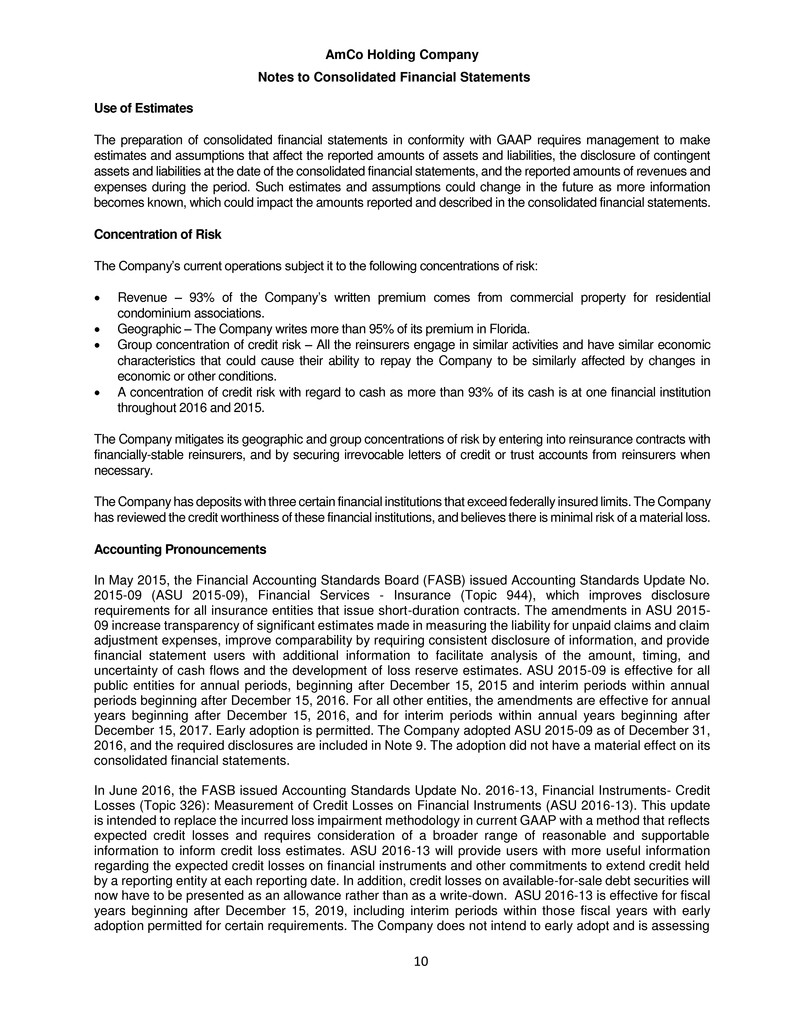
AmCo Holding Company Notes to Consolidated Financial Statements 10 Use of Estimates The preparation of consolidated financial statements in conformity with GAAP requires management to make estimates and assumptions that affect the reported amounts of assets and liabilities, the disclosure of contingent assets and liabilities at the date of the consolidated financial statements, and the reported amounts of revenues and expenses during the period. Such estimates and assumptions could change in the future as more information becomes known, which could impact the amounts reported and described in the consolidated financial statements. Concentration of Risk The Company’s current operations subject it to the following concentrations of risk: • Revenue – 93% of the Company’s written premium comes from commercial property for residential condominium associations. • Geographic – The Company writes more than 95% of its premium in Florida. • Group concentration of credit risk – All the reinsurers engage in similar activities and have similar economic characteristics that could cause their ability to repay the Company to be similarly affected by changes in economic or other conditions. • A concentration of credit risk with regard to cash as more than 93% of its cash is at one financial institution throughout 2016 and 2015. The Company mitigates its geographic and group concentrations of risk by entering into reinsurance contracts with financially-stable reinsurers, and by securing irrevocable letters of credit or trust accounts from reinsurers when necessary. The Company has deposits with three certain financial institutions that exceed federally insured limits. The Company has reviewed the credit worthiness of these financial institutions, and believes there is minimal risk of a material loss. Accounting Pronouncements In May 2015, the Financial Accounting Standards Board (FASB) issued Accounting Standards Update No. 2015-09 (ASU 2015-09), Financial Services - Insurance (Topic 944), which improves disclosure requirements for all insurance entities that issue short-duration contracts. The amendments in ASU 2015- 09 increase transparency of significant estimates made in measuring the liability for unpaid claims and claim adjustment expenses, improve comparability by requiring consistent disclosure of information, and provide financial statement users with additional information to facilitate analysis of the amount, timing, and uncertainty of cash flows and the development of loss reserve estimates. ASU 2015-09 is effective for all public entities for annual periods, beginning after December 15, 2015 and interim periods within annual periods beginning after December 15, 2016. For all other entities, the amendments are effective for annual years beginning after December 15, 2016, and for interim periods within annual years beginning after December 15, 2017. Early adoption is permitted. The Company adopted ASU 2015-09 as of December 31, 2016, and the required disclosures are included in Note 9. The adoption did not have a material effect on its consolidated financial statements. In June 2016, the FASB issued Accounting Standards Update No. 2016-13, Financial Instruments- Credit Losses (Topic 326): Measurement of Credit Losses on Financial Instruments (ASU 2016-13). This update is intended to replace the incurred loss impairment methodology in current GAAP with a method that reflects expected credit losses and requires consideration of a broader range of reasonable and supportable information to inform credit loss estimates. ASU 2016-13 will provide users with more useful information regarding the expected credit losses on financial instruments and other commitments to extend credit held by a reporting entity at each reporting date. In addition, credit losses on available-for-sale debt securities will now have to be presented as an allowance rather than as a write-down. ASU 2016-13 is effective for fiscal years beginning after December 15, 2019, including interim periods within those fiscal years with early adoption permitted for certain requirements. The Company does not intend to early adopt and is assessing

AmCo Holding Company Notes to Consolidated Financial Statements 11 the impact of adopting this new accounting standard on the consolidated financial statements and related disclosures. In August 2016, the FASB issued Accounting Standards Update No. 2016-15, Statement of Cash Flows (Topic 230) (ASU 2016-15). This update is intended to address eight specific cash flow issues with the objective of reducing the existing diversity in practice in how certain cash receipts and cash payments are presented and classified in the statement of cash flows under Topic 230. ASU 2016-15 is effective for annual periods beginning after December 15, 2017, including interim periods within those annual periods, with early adoption permitted. We do not intend to early adopt and are assessing the impact of adopting this new accounting standard on our consolidated financial statements and related disclosures. In February 2016, the FASB issued Accounting Standards Update No. 2016-02, Leases (Topic 842) (ASU 2016-02). This updated is intended to replace existing lease guidance by requiring a lessee to recognize substantially all leases (whether operating or finance leases) on the balance sheet as a right-of-use asset and an associated least liability. Short-term leases of 12 months or less are excluded from this amendment. ASU 2016-02 is effective for fiscal years beginning after December 15, 2018, including interim periods within those fiscal years, with early adoption permitted. We do not intend to early adopt and are assessing the impact of adopting this new accounting standard on our consolidated financial statements and related disclosures. In January 2016, the FASB issued Accounting Standards Update No. 2016-01, Recognition and Measurement of Financial Assets and Financial Liabilities (ASU 2016-01). This update substantially revises standards for the recognition, measurement and presentation of financial instruments. This standard revises an entity's accounting related to (1) the classification and measurement of investments in equity securities and (2) the presentation of certain fair value changes for financial liabilities measured at fair value. It also amends certain disclosure requirements associated with the fair value of financial instruments. ASU 2016- 01 is effective for annual periods beginning after December 15, 2017, including interim periods within those annual periods, with early adoption permitted for certain requirements. We are assessing the impact of adopting this new accounting standard on our consolidated financial statements and related disclosures. In March 2017, the FASB issued Accounting Standards Update No. 2017-08, Premium Amortization on Purchased Callable Debt Securities (ASU 2017-08). This update amends the amortization period for certain purchased callable debt securities held at a premium. This standard will shorten the amortization period for the premium to the earliest call date from the current amortization over the contractual life of the instrument. ASU 2017-08 is effective for fiscal years beginning after December 15, 2018, including interim periods within those annual periods, with early adoption permitted. We are assessing the impact of adopting this new accounting standard on our consolidated financial statements and related disclosures.
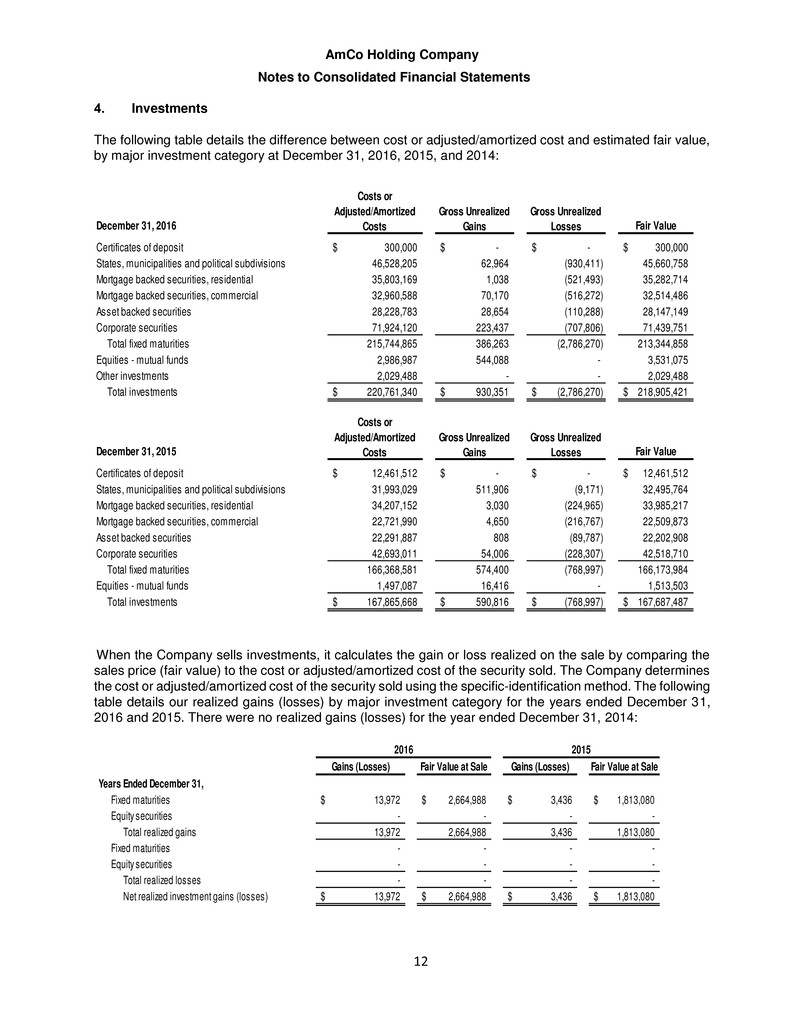
AmCo Holding Company Notes to Consolidated Financial Statements 12 4. Investments The following table details the difference between cost or adjusted/amortized cost and estimated fair value, by major investment category at December 31, 2016, 2015, and 2014: December 31, 2016 Fair Value Certificates of deposit 300,000$ -$ -$ 300,000$ States, municipalities and political subdivisions 46,528,205 62,964 (930,411) 45,660,758 Mortgage backed securities, residential 35,803,169 1,038 (521,493) 35,282,714 Mortgage backed securities, commercial 32,960,588 70,170 (516,272) 32,514,486 Asset backed securities 28,228,783 28,654 (110,288) 28,147,149 Corporate securities 71,924,120 223,437 (707,806) 71,439,751 Total fixed maturities 215,744,865 386,263 (2,786,270) 213,344,858 Equities - mutual funds 2,986,987 544,088 - 3,531,075 Other investments 2,029,488 - - 2,029,488 Total investments 220,761,340$ 930,351$ (2,786,270)$ 218,905,421$ December 31, 2015 Fair Value Certificates of deposit 12,461,512$ -$ -$ 12,461,512$ States, municipalities and political subdivisions 31,993,029 511,906 (9,171) 32,495,764 Mortgage backed securities, residential 34,207,152 3,030 (224,965) 33,985,217 Mortgage backed securities, commercial 22,721,990 4,650 (216,767) 22,509,873 Asset backed securities 22,291,887 808 (89,787) 22,202,908 Corporate securities 42,693,011 54,006 (228,307) 42,518,710 Total fixed maturities 166,368,581 574,400 (768,997) 166,173,984 Equities - mutual funds 1,497,087 16,416 - 1,513,503 Total investments 167,865,668$ 590,816$ (768,997)$ 167,687,487$ Gross Unrealized Losses Gross Unrealized Gains Gross Unrealized Gains Gross Unrealized Losses Costs or Adjusted/Amortized Costs Costs or Adjusted/Amortized Costs When the Company sells investments, it calculates the gain or loss realized on the sale by comparing the sales price (fair value) to the cost or adjusted/amortized cost of the security sold. The Company determines the cost or adjusted/amortized cost of the security sold using the specific-identification method. The following table details our realized gains (losses) by major investment category for the years ended December 31, 2016 and 2015. There were no realized gains (losses) for the year ended December 31, 2014: Gains (Losses) Fair Value at Sale Gains (Losses) Fair Value at Sale Y r En d December 31, Fix d aturiti s 13,972$ 2,664,988$ 3,436$ 1,813,080$ Equity securities - - - - Total realized gains 13,972 2,664,988 3,436 1,813,080 Fixed maturities - - - - Equity securities - - - - Total realized losses - - - - Net realized investment gains (losses) 13,972$ 2,664,988$ 3,436$ 1,813,080$ 20152016

AmCo Holding Company Notes to Consolidated Financial Statements 13 The table below summarizes the Company’s fixed maturities at December 31, 2016 by contractual maturity periods. Actual results may differ as issuers may have the right to call or prepay obligations, with or without penalties, prior to the contractual maturity of those obligations: Amortized Cost Percent of Total Fair Value Percent of Total Due in one year or less 3,300,709$ 2% 3,299,562$ 2% Due after one year through five years 54,571,631 25% 54,582,386 25% Due after five years through ten years 60,879,985 28% 59,518,561 28% Loan backed securities 96,992,540 45% 95,944,349 45% Total fixed maturities 215,744,865$ 100% 213,344,858$ 100% December 31, 2016 The Company is exposed to certain risks and uncertainties as a result of the fluctuations within the market. The nature of those risks and uncertainties may affect the liquidity of the Company’s investments. At December 31, 2016, 2015 and 2014, the Company determined that none of its equity securities or fixed maturities investments reflected an unrealized loss that was other-than-temporarily impaired. During management’s analysis of the investment portfolio, management determined that none of the investments in debt and equity securities that reflected an unrealized loss position were other-than- temporarily impaired. The issuers of the Company’s debt securities continue to make interest payments on a timely basis and have not suffered a material credit rating reduction. The Company does not intend to sell nor is it likely that it would be required to sell the debt securities before it recovered its amortized cost basis. All the issuers of the equity securities the Company owns had near-term prospects that indicated cost basis could be recovered, and the Company also has the ability and the intent to hold these securities until their value equals or exceeds their cost. The major categories of the Company's net investment income are summarized as follows: 2016 2015 2014 Ca h, cash equivalents 318,415$ 203,368$ 48,054$ Fixed maturities 4,085,483 2,642,529 2,174,647 Equity securities 87,502 21,326 - Other investments 81,550 - - Investment income 4,572,950 2,867,223 2,222,701 Investment expenses (239,578) (200,163) (274,521) Net investment income 4,333,372$ 2,667,060$ 1,948,180$ Year Ended December 31, Portfolio monitoring The Company has a comprehensive portfolio monitoring process to identify and evaluate each fixed income and equity security whose carrying value may be other-than-temporarily impaired. For each fixed income security in an unrealized loss position, the Company will determine if the loss is temporary or other-than-temporary. If the Company decides to sell the security or determines that it is more likely than not that it will be required to sell the security before recovery of the cost or amortized cost basis for reasons such as liquidity needs or contractual or regulatory requirements, then the security's decline in fair value is considered other-than-temporary and is recorded in earnings. If the Company has not made the decision to sell the fixed income security and it is uncertain whether or not it will be required to sell the fixed income security before recovery of its amortized cost basis, it will evaluate

AmCo Holding Company Notes to Consolidated Financial Statements 14 whether there is an expectation that cash flows will be sufficient to recover the entire cost or amortized cost basis of the security. The estimated recovery value is calculated by discounting the best estimate of future cash flows at the security's original or current effective rate, as appropriate, and compare this to the cost or amortized cost of the security. If the Company does not expect to receive cash flows sufficient to recover the entire cost or amortized cost basis of the fixed income security, the credit loss component of the impairment is recorded in earnings, with the remaining amount of the unrealized loss related to other factors recognized in other comprehensive income. For equity securities, the Company considers various factors, including whether it has the intent and ability to hold the equity security for a period of time sufficient to recover its cost basis. If the Company lacks the intent and ability to hold to recovery, or if it is expected that the recovery period is extended, the equity security's decline in fair value is considered other-than-temporary and is recorded in earnings. The portfolio monitoring process includes a quarterly review of all securities to identify instances where the fair value of a security compared to its cost or amortized cost (for fixed income securities) or cost (for equity securities) is below established thresholds. The process also includes the monitoring of other impairment indicators such as ratings, ratings downgrades and payment defaults. The securities identified, in addition to other securities for which there may be a concern, are evaluated for potential other-than-temporary impairment using all reasonably available information relevant to the collectability or recovery of the security. Inherent in the evaluation of other-than-temporary impairment for these fixed income and equity securities are assumptions and estimates about the financial condition and future earnings potential of the issue or issuer. Some of the factors that may be considered in evaluating whether a decline in fair value is other- than-temporary are: (1) the financial condition, near-term and long-term prospects of the issue or issuer, including relevant industry specific market conditions and trends, geographic location and implications of rating agency actions and offering prices; (2) the specific reasons that a security is in an unrealized loss position, including overall market conditions which could affect liquidity; and (3) the length of time and extent to which the fair value has been less than amortized cost or cost. The following table presents an aging of the Company’s unrealized investment losses by investment class: Fair Value Gross Unrealized Losses Fair Value Gross Unrealized Losses December 31, 2016 Asset backed 8,809,086$ (101,226)$ 1,241,650$ (9,062)$ CMO 25,462,651 (515,643) 255,305 (628) Corporate 36,095,053 (690,205) 1,284,790 (17,601) Mort ag acked 28,871,439 (511,527) 2,207,815 (9,966) Muni 33,612,836 (930,412) - - T t l f x d mat rities 132,851,065 (2,749,013) 4,989,560 (37,257) Mutual Funds - - - - Tot l 132,851,065$ (2,749,013)$ 4,989,560$ (37,257)$ De emb r 31, 2015 Asset backed 20,705,021$ (89,787)$ -$ -$ CMO 25,508,635 (216,767) - - Corporate 29,382,620 (228,307) - - Mortgage backed 25,164,483 (224,965) - - Muni 2,281,962 (9,171) - - Total 103,042,721$ (768,997)$ -$ -$ Less Than Twelve Months Twelve Months or More The Company determined during its quarterly evaluations of securities for impairment that no investments held in debt and equity securities reflected an unrealized loss position that would be considered other-than- temporarily impaired. The issuers of the Company’s debt securities continue to make interest payments on a timely basis and there is no intent to sell nor is it likely that the Company would be required to sell the debt

AmCo Holding Company Notes to Consolidated Financial Statements 15 securities before the recovery of its amortized cost basis. The near-term prospects of all the issuers of the equity securities currently held indicate that the company could recover its cost basis. The issuers of the Company’s debt securities continue to make interest payments on a timely basis and there is no intent to sell nor is it likely that the Company would be required to sell the debt securities before the recovery of its amortized cost basis. The near-term prospects of all the issuers of the equity securities currently held indicate that the company could recover its cost basis. During the years ended December 31, 2016, 2015, and 2014, the Company recorded no other-than- temporary impairment charges. 5. Fair Value Financial Instruments The fair value for equity securities are obtained from active markets. The fair value for fixed maturity securities are estimated based on values received from third-party securities dealers. The Company’s estimates of fair value reflect the interest rate environment that existed as of the close of business on December 31, 2016, 2015, and 2014. Changes in interest rates subsequent to December 31, 2016 may affect the fair value of the fixed maturity securities. The fair value estimates presented herein are based on pertinent information available to management as of December 31, 2016, 2015, and 2014. Although management is not aware of any factors that would significantly affect the estimated fair value amounts, such amounts have not been comprehensively revalued for purposes of these statutory financial statements since that date, and current estimates of fair value may differ significantly from the amounts presented herein. The following methods and assumptions were used to estimate the fair value of each class of significant financial instruments for which it is practical to estimate that value: Cash and cash equivalents: The carrying amounts reported in the Consolidated Balance Sheets approximate their fair value due to their short maturity. Fixed maturities and mutual funds: Fair values are based on quoted market prices, or dealer quotes. For bonds not actively traded, fair values are estimated using values obtained from independent pricing services. Other investments are accounted for at fair value which is estimated to be equal to its cost basis. The Company’s financial assets and liabilities carried at fair value have been classified, for disclosure purposes, based on a hierarchy that prioritized the inputs to valuation techniques used to measure fair value into three broad levels. The hierarchy gives the highest priority to fair values determined using unadjusted quote prices in active markets for identical assets or liabilities (Level 1) and the lowest priority to fair values determined using unobservable inputs (Level 3). An asset’s or liability’s classification is determined based on the lowest level input that is significant to its measurement. For example, a Level 3 fair value measurement may include inputs that are both observable (Levels 1 and 2) and unobservable (Level 3). The levels of the fair value hierarchy are as follows: Level 1: Unadjusted quoted prices in active markets for identical assets or liabilities that the Company has the ability to access at the measurement date. Level 2: Valuations derived from inputs other than quoted market prices included within Level 1 that are observable for the asset or liability, either directly or indirectly, such as: • Quoted prices for similar assets or liabilities in active markets. • Quoted prices for identical or similar assets or liabilities in markets that are not active. • Inputs other than quoted prices that are observable for the asset or liability.

AmCo Holding Company Notes to Consolidated Financial Statements 16 • Inputs that are derived principally from or corroborated by observable market data by correlation or other means. Level 3: Valuations are derived from techniques that require significant unobservable inputs. The unobservable inputs reflect the Company’s own assumptions about the assumptions that market participants would use in pricing the asset or liability. The following table presents the Company’s fair value hierarchy for securities carried at fair value on a recurring basis: December 31, 2016 Fair Value Level 1 Level 2 Level 3 Certificates of deposit $ 300,000 $ - $ 300,000 $ - States, municipalities and political subdivisions 45,660,758 - 45,660,758 - Mortgage Backed Securities, Residential 35,282,714 - 35,282,714 - Mortgage Backed Securities, Commercial 32,514,486 - 32,514,486 - Asset Backed Securities 28,147,149 - 28,147,149 - Corporate securities 71,439,751 - 71,439,751 - Total Fixed Maturities 213,344,858 - 213,344,858 - Equities -Mutual Funds 3,531,075 3,531,075 - - Other Investments 2,029,488 - 2,029,488 - Total Investments $ 218,905,421 $ 3,531,075 $ 215,374,346 $ - December 31, 2015 Fair Value Level 1 Level 2 Level 3 Certificates of deposit $ 12,461,512 $ - $ 12,461,512 $ - Stat s, municipalities and political subdivisions 32,495,764 - 32,495,764 - Mortgage Backed Securities, Residential 33,985,217 - 33,985,217 - Mortgage Backed Securities, Commercial 22,509,873 - 22,509,873 - Asset Backed Securities 22,202,908 - 22,202,908 - Corporate securities 42,518,710 - 42,518,710 - Total Fixed Maturities 166,173,984 - 166,173,984 - Equities -Mutual Funds 1,513,503 1,513,503 - - Total Investments $ 167,687,487 $ 1,513,503 $ 166,173,984 $ - The fair values of certificates of deposits included in fixed maturities are at fair value. Fair values of fixed maturity securities and mutual funds are based on quoted market prices, where available. The Company also utilizes an independent third-party valuation service to gather, analyze, and interpret market information to derive fair value estimates for individual investments, based upon market-accepted methodologies and assumptions. The methodologies used by these independent third-party valuation services are reviewed and understood by management, through periodic discussion with, and information provided by, the valuation services. Other investments In March 2016, the Company acquired investments in a limited partnership, recorded in the other investments line of our Consolidated Balance Sheets. These are currently accounted for at fair value which is estimated to be equal to its cost basis. The cost and carrying value of the Company’s investments in the limited partnership DCR Partners, VII, L. P. was $2,029,488 at December 31, 2016.

AmCo Holding Company Notes to Consolidated Financial Statements 17 6. Deferred Policy Acquisition Costs The Company anticipates that the deferred policy acquisition costs will be fully recoverable in the near term. The table below depicts the activity with regard to deferred policy acquisition costs: 2016 2015 Balance at January 1, 31,332,600$ 33,164,565$ Policy acquisition costs deferred 64,104,323 73,786,349 Amortization (67,194,678) (75,618,314) Balance at December 31, 28,242,245$ 31,332,600$ 7. Income Taxes The following table summarizes the provision for income taxes: 2016 2015 2014 F deral: Curr nt 14,483,586$ 18,154,071$ 23,015,854$ Deferred (1,799,011) 3,475,946 (922,974) Pr vision for F deral income tax expense 12,684,575 21,630,017 22,092,880 State: Current 2,381,263 1,155,287 370,322 Deferred (213,336) 613,402 (162,878) Provision for State income tax expense 2,167,927 1,768,689 207,444 Provision for income taxes 14,852,502$ 23,398,706$ 22,300,324$ December 31, The actual income tax expense differs from the expected income tax expense computed by applying the combined applicable effective federal and state tax rates to income before the provision for income taxes as follows: 2016 2015 2014 Expected income tax expense at federal rate 16,384,363$ 20,956,163$ 23,542,124$ State tax expense, net of federal deduction benefit 1,602,758 1,149,647 134,839 Prior period adjustment (1,436,193) 1,278,196 (1,278,196) Other, net (1,698,426) 14,700 (98,443) Reported income tax expense 14,852,502$ 23,398,706$ 22,300,324$ December 31, Deferred income taxes reflect the net tax effects of temporary differences between the carrying amounts of assets and liabilities for financial reporting purposes and the amounts used for income tax purposes.

AmCo Holding Company Notes to Consolidated Financial Statements 18 The table below summarizes the significant components of net deferred tax liability: 2016 2015 Deferred tax assets: Unearned premiums 5,408,711$ 5,298,043$ Tax-related discount on loss reserve 736,639 520,142 Ceding commission 507,572 726,554 Unrealized loss 707,156 68,734 T tal deferred tax assets 7,360,078 6,613,473 Deferred tax liabilities: Deferred acquisition costs (10,789,638) (12,086,550) Intangible asset - (607,254) Total deferred tax liabilities (10,789,638) (12,693,804) Net deferred tax liability (3,429,560)$ (6,080,331)$ December 31, In assessing the net realizable value of deferred tax assets, management considers whether it is more likely than not that the Company will not realize some portion or all of the deferred tax assets. The ultimate realization of deferred tax assets depends upon the generation of future taxable income during the periods in which those temporary differences become deductible. Management considers the scheduled reversal of deferred tax liabilities, projected future taxable income and tax planning strategies in making this assessment. The statute of limitations related to the Company’s consolidated Federal income tax returns and its Florida income tax returns expired for all tax years up to and including 2012; therefore, only the 2013 through 2016 tax years remain subject to examination by taxing authorities. No taxing authorities are currently examining any of the Company’s federal or state income tax returns. As of December 31, 2016, 2015 and 2014, the Company has not taken any uncertain tax positions with regard to its tax returns. 8. Related Parties ACIC is a wholly owned subsidiary of AmCo which was wholly owned by BB&T through May 31, 2015. BB&T entered into an agreement with AmCo and RDX whereby effective at 12:01 a.m. June 1, 2015, RDX acquired 100% of the stock of AmCo. RDX is 67.2% owned by Dan Peed or an entity controlled by Dan Peed, the Chief Executive Officer of the Company. Leah Peed owns 16.8% and no other investor owns 5% or more of RDX. BlueLine Re is a wholly owned subsidiary of BlueLine Cayman Holdings, which is a wholly owned subsidiary of AmCo. AmRisc, a Managing General Underwriter, handles the underwriting, claims processing, premium collection and reinsurance review for the Company. Dan Peed owns approximately 7.7% of AmRisc. In addition, he is also the Chief Executive Officer of AmRisc. Peed Management provides accounting services for the Company through a consulting services contract entered into effective June 1, 2015. $573,518 and $350,000 was incurred through December 31, 2016 and 2015, respectively. The Company (ACIC) recorded $250,212,939 of direct written premiums for 2016 in accordance with the managing general agent underwriting contract with AmRisc, resulting in fees and commission (including a
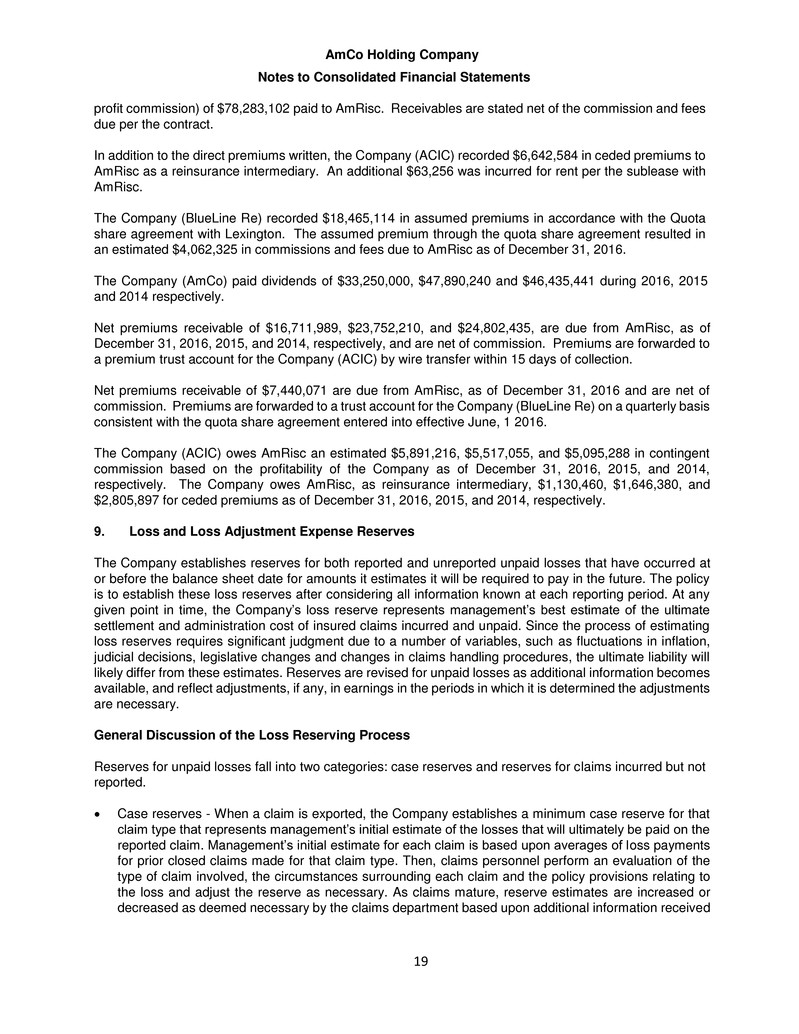
AmCo Holding Company Notes to Consolidated Financial Statements 19 profit commission) of $78,283,102 paid to AmRisc. Receivables are stated net of the commission and fees due per the contract. In addition to the direct premiums written, the Company (ACIC) recorded $6,642,584 in ceded premiums to AmRisc as a reinsurance intermediary. An additional $63,256 was incurred for rent per the sublease with AmRisc. The Company (BlueLine Re) recorded $18,465,114 in assumed premiums in accordance with the Quota share agreement with Lexington. The assumed premium through the quota share agreement resulted in an estimated $4,062,325 in commissions and fees due to AmRisc as of December 31, 2016. The Company (AmCo) paid dividends of $33,250,000, $47,890,240 and $46,435,441 during 2016, 2015 and 2014 respectively. Net premiums receivable of $16,711,989, $23,752,210, and $24,802,435, are due from AmRisc, as of December 31, 2016, 2015, and 2014, respectively, and are net of commission. Premiums are forwarded to a premium trust account for the Company (ACIC) by wire transfer within 15 days of collection. Net premiums receivable of $7,440,071 are due from AmRisc, as of December 31, 2016 and are net of commission. Premiums are forwarded to a trust account for the Company (BlueLine Re) on a quarterly basis consistent with the quota share agreement entered into effective June, 1 2016. The Company (ACIC) owes AmRisc an estimated $5,891,216, $5,517,055, and $5,095,288 in contingent commission based on the profitability of the Company as of December 31, 2016, 2015, and 2014, respectively. The Company owes AmRisc, as reinsurance intermediary, $1,130,460, $1,646,380, and $2,805,897 for ceded premiums as of December 31, 2016, 2015, and 2014, respectively. 9. Loss and Loss Adjustment Expense Reserves The Company establishes reserves for both reported and unreported unpaid losses that have occurred at or before the balance sheet date for amounts it estimates it will be required to pay in the future. The policy is to establish these loss reserves after considering all information known at each reporting period. At any given point in time, the Company’s loss reserve represents management’s best estimate of the ultimate settlement and administration cost of insured claims incurred and unpaid. Since the process of estimating loss reserves requires significant judgment due to a number of variables, such as fluctuations in inflation, judicial decisions, legislative changes and changes in claims handling procedures, the ultimate liability will likely differ from these estimates. Reserves are revised for unpaid losses as additional information becomes available, and reflect adjustments, if any, in earnings in the periods in which it is determined the adjustments are necessary. General Discussion of the Loss Reserving Process Reserves for unpaid losses fall into two categories: case reserves and reserves for claims incurred but not reported. • Case reserves - When a claim is exported, the Company establishes a minimum case reserve for that claim type that represents management’s initial estimate of the losses that will ultimately be paid on the reported claim. Management’s initial estimate for each claim is based upon averages of loss payments for prior closed claims made for that claim type. Then, claims personnel perform an evaluation of the type of claim involved, the circumstances surrounding each claim and the policy provisions relating to the loss and adjust the reserve as necessary. As claims mature, reserve estimates are increased or decreased as deemed necessary by the claims department based upon additional information received

AmCo Holding Company Notes to Consolidated Financial Statements 20 regarding the loss, the results of on-site reviews and any other information gathered while reviewing the claims. • Reserves for losses incurred but not reported (IBNR reserves) - IBNR reserves include true IBNR reserves plus “bulk” reserves. Bulk reserves represent additional amounts that cannot be allocated to particular claims, but which are necessary to estimate ultimate losses on reported and unreported claims. IBNR reserves are estimated by projecting the ultimate losses using the methods discussed below and then deducting actual loss payments and case reserves from the projected ultimate losses. Management reviews and adjusts IBNR reserves on a quarterly basis based on information available at the balance sheet date. When reserves are established, management analyzes various factors such as historical loss experience and that of the insurance industry, claims frequency and severity, business mix, claims processing procedures, legislative enactments, judicial decisions and legal developments in imposition of damages, and general economic conditions, including inflation. A change in any of these factors from the assumptions implicit in the estimates will cause the ultimate loss experience to be better or worse than indicated by the reserves, and the difference could be material. Due to the interaction of the aforementioned factors, there is no precise method for evaluating the impact of any one specific factor in isolation, and an element of judgment is ultimately required. Due to the uncertain nature of any projection of the future, the ultimate amount the Company will pay for losses will be different from the reserves recorded. However, in management’s judgment, the Company employs techniques and assumptions that are appropriate, and the resulting reserve estimates are reasonable, given the information available at the balance sheet date. The Company determines ultimate losses by using multiple actuarial methods to determine an actuarial estimate within a relevant range of indications calculated using generally accepted actuarial techniques. Selection of the actuarial estimate is influenced by the analysis of historical loss and claim experience since inception. For each accident year, the Company estimates the ultimate incurred losses for both reported and unreported claims. In establishing this estimate, management reviewed the results of various actuarial methods discussed below. Estimation of the Reserves for Unpaid Losses and Allocated Loss Adjustment Expenses The Company calculates estimates of ultimate losses by using the following actuarial methods. The Company separately calculates the methods using paid loss data and incurred loss data. In the versions of these methods based on incurred loss data, the incurred losses are defined as paid losses plus case reserves. For this discussion of the loss reserving process, the word “segment” refers to a subgrouping of claims data, such as by geographic area and/or by particular line of business; it does not refer to operating segments. • Incurred Development Method - The incurred development method is based upon the assumption that the relative change in a given year’s incurred loss estimates from one evaluation point to the next is similar to the relative change in prior years’ reported loss estimates at similar evaluation points. In utilizing this method, actual annual historical incurred loss data is evaluated. Successive years can be arranged to form a triangle of data. Loss development factors (LDFs) are calculated to measure the change in cumulative incurred costs from one evaluation point to the next. These historical LDFs and comparable industry benchmark factors form the basis for selecting the LDFs used in projecting the current valuation of losses to an ultimate basis. This method’s implicit assumption is that the relative adequacy of case reserves has been consistent over time, and that there have been no material changes in the rate at which claims have been reported. The paid development method is similar to the incurred development method. While the paid development methods have the disadvantage of not recognizing the information by current case reserves, it has the advantage of avoiding potential distortions in the

AmCo Holding Company Notes to Consolidated Financial Statements 21 data due to changes in case reserving methodology. The paid development method’s implicit assumption is that the rate of payment of claims has been relatively consistent over time. • Expected Loss Method - In the expected loss method, ultimate loss projections are based upon some prior measure of the anticipated losses, usually relative to some measure of exposure (e.g., earned house years). An expected loss cost is applied to the measure of exposure to determine estimated ultimate losses for each year. Actual losses are not considered in this calculation. This method has the advantage of stability over time, because the ultimate loss estimates do not change unless the exposures or loss costs change. However, this advantage of stability is offset by a lack of responsiveness, since this method does not consider actual loss experience as it emerges. This method is based on the assumption that the loss cost per unit of exposure is a good indication of ultimate losses. It can be entirely dependent on pricing assumptions (e.g., historical experience adjusted for loss trend). • Bornhuetter-Ferguson Method - The incurred Bornhuetter-Ferguson (B-F) method is essentially a blend of two other methods. The first method is the loss development method whereby actual incurred losses are multiplied by an expected LDF. For slow reporting coverages, the loss development method can lead to erratic and unreliable projections because a relatively small swing in early reporting can result in a large swing in ultimate projections. The second method is the expected loss method whereby the IBNR estimate equals the difference between a predetermined estimate of expected losses and actual incurred losses. The incurred B-F method combines these two methods by setting ultimate losses equal to actual incurred losses plus expected unreported losses. As an experience year matures and expected unreported losses become smaller, the initial expected loss assumption becomes gradually less important. Two parameters are needed to apply the B-F method: the initial expected loss cost and the expected reporting pattern (LDFs). This method is often used for long-tail lines and in situations where the incurred loss experience is relatively immature or lacks sufficient credibility for the application of other methods. The paid B-F method is analogous to the incurred B-F method using paid losses and development patterns in place of incurred losses and patterns. • Paid-to-Paid Development Method - In addition to the aforementioned methods, the Company also relies upon the paid-to-paid development method to project ultimate unallocated loss adjustment expense (ULAE). Ratios of paid ULAE to paid loss and allocated loss adjustment expense (ALAE) are compiled by calendar year and a paid-to-paid ratio selection is made. The selected ratio is applied to the estimated IBNR amounts and one half of this ratio is applied to case reserves. This method is derived from rule of thumb that half of ULAE is incurred when a claim is opened and the other half is incurred over the remaining life of the claim. Reliance and Selection of Methods The various methods used have strengths and weaknesses that depend upon the circumstances of the segment and the age of the claims experience analyzed. The nature of the Company’s book of business allows it to place substantial, but not exclusive, reliance on the loss development methods, the selected LDFs, represent the most critical aspect of the loss reserving process. Reasonably-Likely Changes in Variables As previously noted, the Company evaluates several factors when exercising judgment in the selection of the loss development factors that ultimately drive the determination of loss reserves. The process of establishing reserves is complex and necessarily imprecise, as it involves using judgment that is affected by many variables. The Company believes a reasonably-likely change in almost any of these aforementioned factors could have an impact on reported results, financial condition and liquidity. However, the Company

AmCo Holding Company Notes to Consolidated Financial Statements 22 does not believe any reasonably-likely changes in the frequency or severity of claims would have a material impact. On an annual basis, the consulting actuary issues a statement of actuarial opinion that documents the actuary’s evaluation of the adequacy of unpaid loss obligations under the terms of the Company’s policies. Management reviews the analysis underlying the actuary’s opinion and compare the projected ultimate losses per the actuary’s analysis to the Company’s projection of ultimate losses to ensure that the reserve for unpaid losses recorded at each annual balance sheet date is based upon analysis of all internal and external factors related to known and unknown claims and to ensure our reserve is within guidelines promulgated by the National Association of Insurance Commissioners (NAIC). AmRisc’s claims staff monitors and directs all aspects of the claims process through Cramer Johnson Wiggins and Associates (CJW). CJW assigns the fieldwork to third-party claims adjusting companies, none of whom have the authority to settle or pay any claims on the Company’s behalf. The third-party claims adjusting companies conduct inspection of the damaged property and prepare initial estimates. CJW reviews the inspection reports and initial estimates to determine the amounts to be paid to the policyholder in accordance with the terms and conditions of the policy in effect at the time that the policyholder incurs the loss. CJW maintains strategic relationships with multiple claims adjusting companies that can be engaged should we need additional non-catastrophe claims servicing capacity. Management believes the combination of AmRisc and CJW resources and their relationships with external claims servicing companies provide an adequate level of claims servicing in the event catastrophes affect policyholders. The following is information about incurred claims development as of December 31, 2016, net of reinsurance, as well as cumulative claim frequency and the total of incurred-but-not-reported liability plus expected development on reported claims included within the net incurred claims amounts. The information about incurred claims development for the years ended December 31, 2007, to 2015 is presented as supplementary information. Commercial Insurance Dollars in thousands Accident Year 2007 2008 2009 2010 2011 2012 2013 2014 2015 2016 2007 $ 1,034 $ 14 $ 14 $ 14 $ 16 $ 16 $ 16 $ 16 $ 16 $ 16 $ - 11 2008 - 12,428 3,844 1,939 1,905 1,905 1,905 1,905 1,905 1,902 2 261 2009 - - 11,323 5,233 3,490 3,490 3,490 3,490 3,490 3,489 4 383 2010 - - - 12,134 4,160 4,160 4,160 4,160 4,160 4,112 - 580 2011 - - - - 9,142 9,142 9,142 9,142 9,142 9,030 37 757 2012 - - - - - 9,771 9,771 9,771 9,771 8,671 12 799 2013 - - - - - - 11,826 11,826 11,826 8,382 1,133 732 2014 - - - - - - - 15,752 15,752 16,311 3,014 674 2015 - - - - - - - - 16,504 20,379 2,735 799 2016 - - - - - - - - - 33,729 17,813 909 Total $ 106,021 The Company's first audit in accordance with GAAP was for the year ended 2015. As part of the evaluation it was determined that all incurred losses should be reported for the 2011 - 2014 years based upon the 2015 acturially report which effectively adjusted the years to reflect no development in losses during those years. Incurred Claims and Allocated Claim Adjustment Expenses, Net of Reinsurance As of December 31, 2016 Total of Incurred- but-Not-Reported Liabilities Plus Expected Development on Reported Claims Cumulative Number of Reported Claims For the Years Ended December 31,

AmCo Holding Company Notes to Consolidated Financial Statements 23 E&S Insur nce Dollars i thousands Accident Year 2007 2008 2009 2010 2011 2012 2013 2014 2015 2016 2016 n/a n/a n/a n/a n/a n/a n/a n/a n/a $ 1,818 $ 526 115 Total $ 1,818 Incurred Claims and Allocated Claim Adjustment Expenses, Net of Reinsurance As of December 31, 2016 Total of Incurred- but-Not-Reported Liabilities Plus Expected Cumulative Number of Reported Claims For the Years Ended December 31, The following is information about paid claims development as of December 31, 2016, net of reinsurance. The information about paid claims development for the years ended December 31, 2007, to 2015, is presented as supplementary information. Commercial Insurance Dollars in thousands Accident Year 2007 2008 2009 2010 2011 2012 2013 2014 2015 2016 2007 $ - $ 14 $ 14 $ 14 $ 14 $ 16 $ 16 $ 16 $ 16 $ 16 2008 - 700 1,619 1,678 1,665 1,897 1,927 1,902 1,902 1,900 2009 - - 1,639 3,616 3,410 3,415 3,920 3,446 3,471 3,485 2010 - - - 1,968 3,127 3,461 3,966 3,909 3,909 4,112 2011 - - - - 3,541 6,241 7,605 7,846 8,825 8,851 2012 - - - - - 4,583 6,942 6,893 7,543 8,552 2013 - - - - - - 2,958 5,127 5,317 7,248 2014 - - - - - - - 6,379 9,452 13,212 2015 - - - - - - - - 10,188 17,134 2016 - - - - - - - - - 10,434 Total $ 74,944 - $ 56,159 I Dollars in thousands Accident Year 2007 2008 2009 2010 2011 2012 2013 2014 2015 2016 2016 n/a n/a n/a n/a n/a n/a n/a n/a n/a $ 222 Total $ 222 - $ 1,596 Cumulative Paid Claims and Allocated Claim Adjustment Expenses, Net of Reinsurance For the Years Ended December 31, All outstanding liabilities before 2007, net of reinsurance Liabilities for claims and claim adjustment expenses, net of reinsurance All outstanding liabilities before 2007, net of reinsurance Liabilities for claims and claim adjustment expenses, net of reinsurance Cumulative Paid Claims nd Allocated Claim Adjustment Expenses, Net of Reinsura ce For the Years Ended December 31,
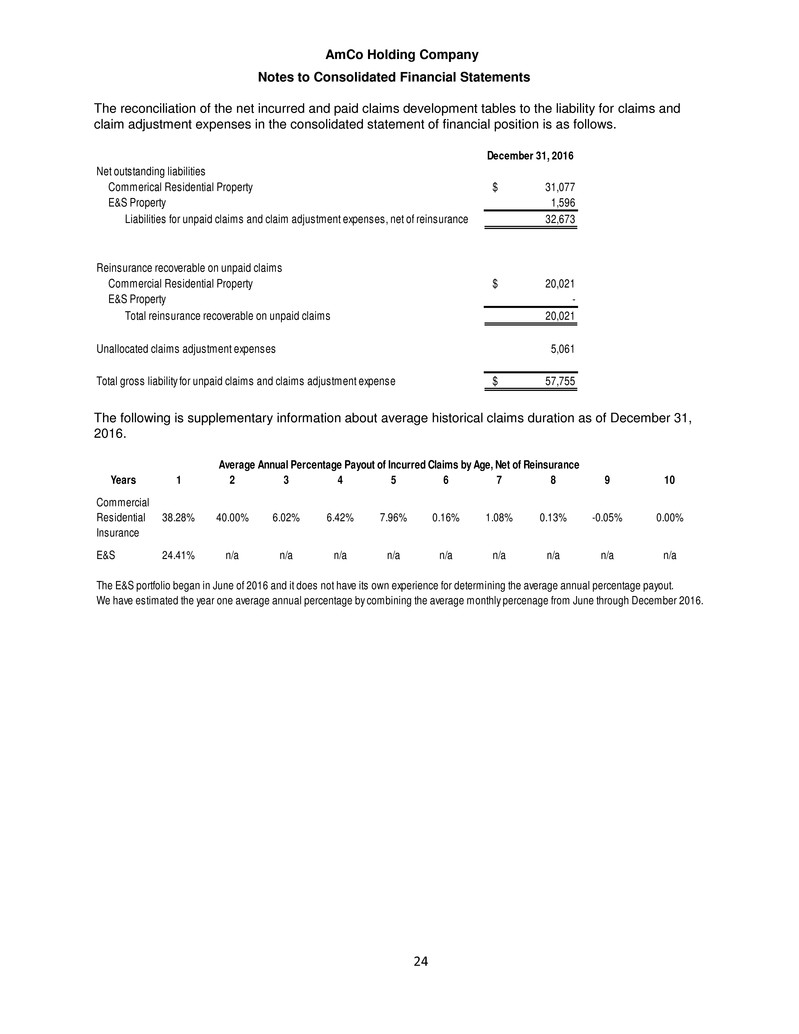
AmCo Holding Company Notes to Consolidated Financial Statements 24 The reconciliation of the net incurred and paid claims development tables to the liability for claims and claim adjustment expenses in the consolidated statement of financial position is as follows. December 31, 2016 Net outstanding liabilities Commerical Residential Property $ 31,077 E&S Property 1,596 Liabilities for unpaid claims and claim adjustment expenses, net of reinsurance 32,673 Reinsurance recoverable on unpaid claims Commerci l Resi ential Property $ 20,021 E&S Property - Total reinsurance recoverable on unpaid claims 20,021 Unallocated claims adjustment expenses 5,061 Total gross liability for unpaid claims and claims adjustment expense $ 57,755 The following is supplementary information about average historical claims duration as of December 31, 2016. Years 1 2 3 4 5 6 7 8 9 10 Co erci l Residential Insurance 38.28% 40.00% 6.02% 6.42% 7.96% 0.16% 1.08% 0.13% -0.05% 0.00% E&S 24.41% n/a n/a n/a n/a n/a n/a n/a n/a n/a The E&S portfolio began in June of 2016 and it does not have its own experience for determining the average annual percentage payout. We have estimated the year one average annual percentage by combining the average monthly percenage from June through December 2016. Average Annual Perc tage Payout of Incurred Claims by Age, Net of Reinsurance
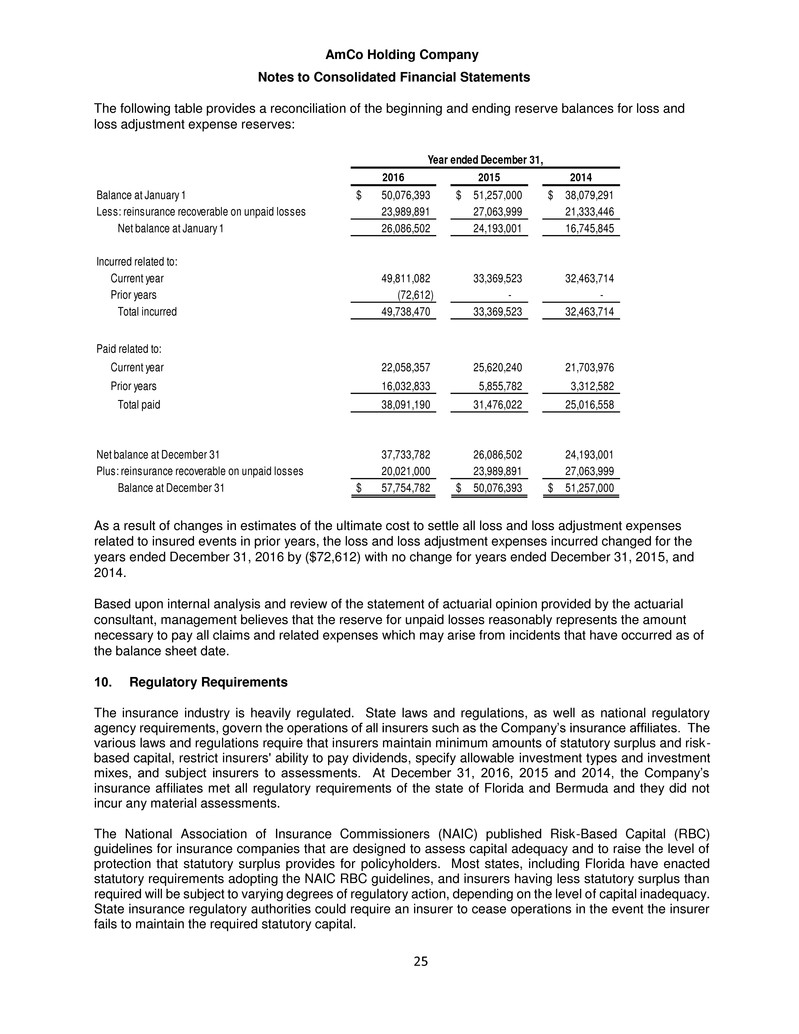
AmCo Holding Company Notes to Consolidated Financial Statements 25 The following table provides a reconciliation of the beginning and ending reserve balances for loss and loss adjustment expense reserves: 2016 2015 2014 Balance at January 1 50,076,393$ 51,257,000$ 38,079,291$ Less: reinsurance recoverable on unpaid losses 23,989,891 27,063,999 21,333,446 Net balance at January 1 26,086,502 24,193,001 16,745,845 Incurred related to: Current year 49,811,082 33,369,523 32,463,714 Prior years (72,612) - - Total incurred 49,738,470 33,369,523 32,463,714 Paid related to: Current year 22,058,357 25,620,240 21,703,976 Pri r years 16,032,833 5,855,782 3,312,582 Total paid 38,091,190 31,476,022 25,016,558 Net balance at December 31 37,733,782 26,086,502 24,193,001 Plus: reinsurance recoverable on unpaid losses 20,021,000 23,989,891 27,063,999 Balance at December 31 57,754,782$ 50,076,393$ 51,257,000$ Year ended December 31, As a result of changes in estimates of the ultimate cost to settle all loss and loss adjustment expenses related to insured events in prior years, the loss and loss adjustment expenses incurred changed for the years ended December 31, 2016 by ($72,612) with no change for years ended December 31, 2015, and 2014. Based upon internal analysis and review of the statement of actuarial opinion provided by the actuarial consultant, management believes that the reserve for unpaid losses reasonably represents the amount necessary to pay all claims and related expenses which may arise from incidents that have occurred as of the balance sheet date. 10. Regulatory Requirements The insurance industry is heavily regulated. State laws and regulations, as well as national regulatory agency requirements, govern the operations of all insurers such as the Company’s insurance affiliates. The various laws and regulations require that insurers maintain minimum amounts of statutory surplus and risk- based capital, restrict insurers' ability to pay dividends, specify allowable investment types and investment mixes, and subject insurers to assessments. At December 31, 2016, 2015 and 2014, the Company’s insurance affiliates met all regulatory requirements of the state of Florida and Bermuda and they did not incur any material assessments. The National Association of Insurance Commissioners (NAIC) published Risk-Based Capital (RBC) guidelines for insurance companies that are designed to assess capital adequacy and to raise the level of protection that statutory surplus provides for policyholders. Most states, including Florida have enacted statutory requirements adopting the NAIC RBC guidelines, and insurers having less statutory surplus than required will be subject to varying degrees of regulatory action, depending on the level of capital inadequacy. State insurance regulatory authorities could require an insurer to cease operations in the event the insurer fails to maintain the required statutory capital.
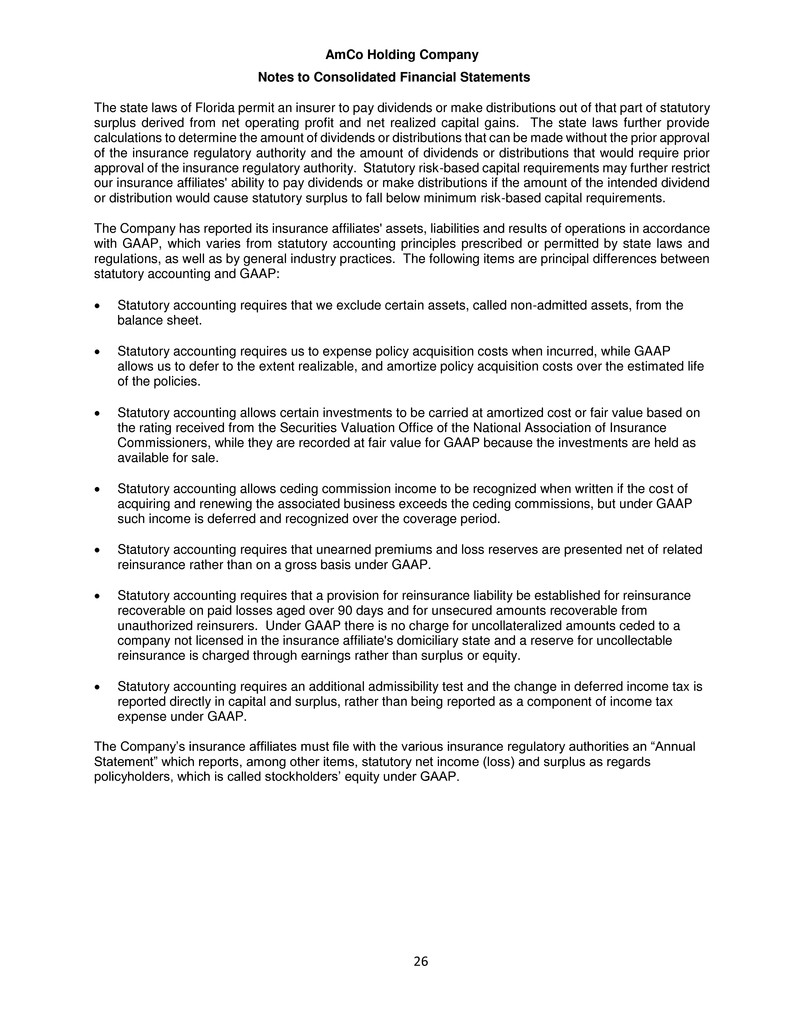
AmCo Holding Company Notes to Consolidated Financial Statements 26 The state laws of Florida permit an insurer to pay dividends or make distributions out of that part of statutory surplus derived from net operating profit and net realized capital gains. The state laws further provide calculations to determine the amount of dividends or distributions that can be made without the prior approval of the insurance regulatory authority and the amount of dividends or distributions that would require prior approval of the insurance regulatory authority. Statutory risk-based capital requirements may further restrict our insurance affiliates' ability to pay dividends or make distributions if the amount of the intended dividend or distribution would cause statutory surplus to fall below minimum risk-based capital requirements. The Company has reported its insurance affiliates' assets, liabilities and results of operations in accordance with GAAP, which varies from statutory accounting principles prescribed or permitted by state laws and regulations, as well as by general industry practices. The following items are principal differences between statutory accounting and GAAP: • Statutory accounting requires that we exclude certain assets, called non-admitted assets, from the balance sheet. • Statutory accounting requires us to expense policy acquisition costs when incurred, while GAAP allows us to defer to the extent realizable, and amortize policy acquisition costs over the estimated life of the policies. • Statutory accounting allows certain investments to be carried at amortized cost or fair value based on the rating received from the Securities Valuation Office of the National Association of Insurance Commissioners, while they are recorded at fair value for GAAP because the investments are held as available for sale. • Statutory accounting allows ceding commission income to be recognized when written if the cost of acquiring and renewing the associated business exceeds the ceding commissions, but under GAAP such income is deferred and recognized over the coverage period. • Statutory accounting requires that unearned premiums and loss reserves are presented net of related reinsurance rather than on a gross basis under GAAP. • Statutory accounting requires that a provision for reinsurance liability be established for reinsurance recoverable on paid losses aged over 90 days and for unsecured amounts recoverable from unauthorized reinsurers. Under GAAP there is no charge for uncollateralized amounts ceded to a company not licensed in the insurance affiliate's domiciliary state and a reserve for uncollectable reinsurance is charged through earnings rather than surplus or equity. • Statutory accounting requires an additional admissibility test and the change in deferred income tax is reported directly in capital and surplus, rather than being reported as a component of income tax expense under GAAP. The Company’s insurance affiliates must file with the various insurance regulatory authorities an “Annual Statement” which reports, among other items, statutory net income (loss) and surplus as regards policyholders, which is called stockholders’ equity under GAAP.

AmCo Holding Company Notes to Consolidated Financial Statements 27 The table below reconciles our consolidated GAAP net income to the statutory net income of our insurance affiliates: 2016 2015 2014 Consolidated GAAP net income 30,368,026$ 36,476,044$ 44,962,888$ Increase (decrease) due to: Assessments (33,810) (339,665) (1,676,851) Deferred cquisition costs 3,124,166 1,978,207 (510,974) C mmissio s (567,678) 962,806 (1,147,507) IBNR reserves - (8,692,000) 4,832,543 Operations of non-statutory entities 14,285 2,262 9,219 Miscellaneous expense (89) - - Deferred income taxes 1,200,584 4,087,681 1,420,922 Statutory net income of insurance affiliates 34,105,484$ 34,475,335$ 47,890,240$ Year Ended December 31, The table below reconciles our consolidated GAAP stockholders’ equity to the surplus as regards policyholders of our insurance affiliates: 2016 2015 Consolidated GAAP ockholders' quity 197,589 5 3$ 195,822 681$ Increase (d crease) due to: acquisition costs (28 242 245) (3 332 600) Deferred income taxes 12 510 974 13 028 7 1 N n-admitted assets (3,304,558) (4,816,144) Unrealized (gain) loss investments 2,382,406 194,597 Equity of non-statutory entities (1,177,092) (31,466) Commissions 1,315,806 1,883,483 Other (89) - Statutory surplus as regards policyholders of insurance affiliates 181,074,765$ 174,749,292$ Year Ended December 31, Florida Statue 624.408 requires ACIC to maintain minimum capital and surplus equal to the greater of 10% of its total liabilities or $5,000,000 and to meet the risk-based capital requirements. Additionally, Florida Statute 624.4095 requires ACIC to maintain a ratio of the product of written premiums times 0.90 to surplus of no greater than 10-to-1 for gross written premiums and 4-to-1 for net written premiums. ACIC is in compliance with all of these requirements. BlueLine Re is required to maintain minimum surplus equal to its total exposure from a 250 year event and from multiple events less reinsurance coverage purchased less unearned premium plus loss reserves. BlueLine Re received a capital contribution of $5,668,171 in accordance with the agreements signed in August 2016 to fulfill this requirement from its parent. 11. Dividend Restrictions Dividends from ACIC to the Company are restricted per Florida Statute 628.371 to the lesser of 10% of surplus or net income from operations not including realized gains unless advanced notice is provided to the
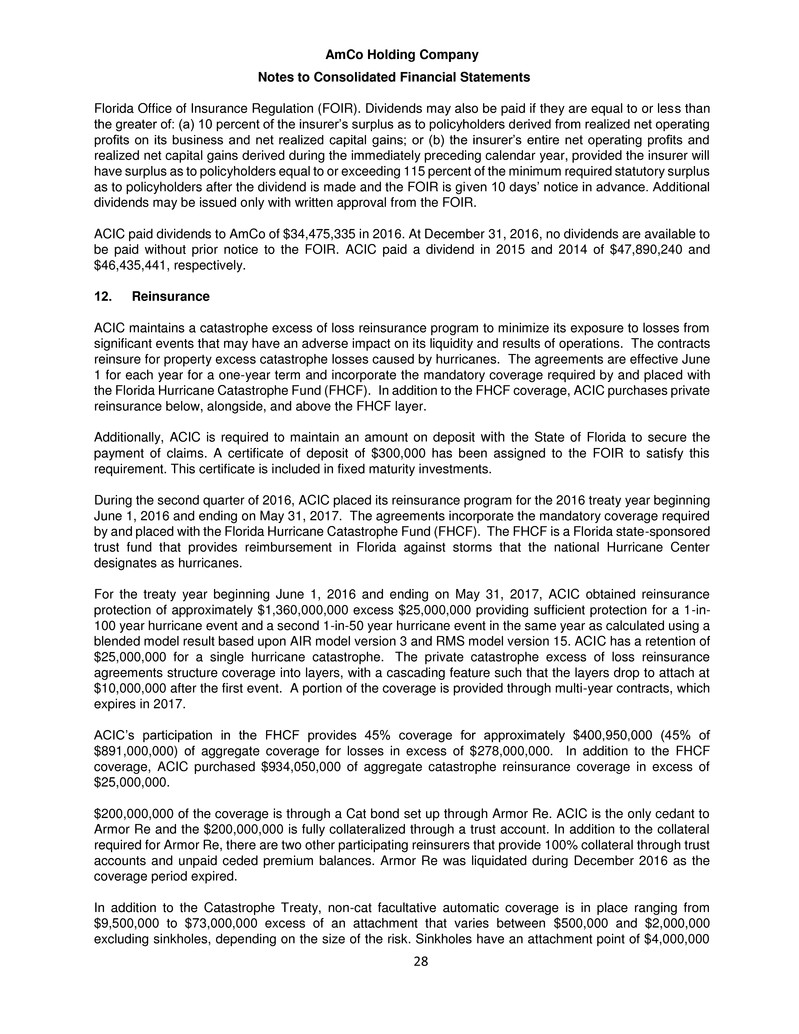
AmCo Holding Company Notes to Consolidated Financial Statements 28 Florida Office of Insurance Regulation (FOIR). Dividends may also be paid if they are equal to or less than the greater of: (a) 10 percent of the insurer’s surplus as to policyholders derived from realized net operating profits on its business and net realized capital gains; or (b) the insurer’s entire net operating profits and realized net capital gains derived during the immediately preceding calendar year, provided the insurer will have surplus as to policyholders equal to or exceeding 115 percent of the minimum required statutory surplus as to policyholders after the dividend is made and the FOIR is given 10 days’ notice in advance. Additional dividends may be issued only with written approval from the FOIR. ACIC paid dividends to AmCo of $34,475,335 in 2016. At December 31, 2016, no dividends are available to be paid without prior notice to the FOIR. ACIC paid a dividend in 2015 and 2014 of $47,890,240 and $46,435,441, respectively. 12. Reinsurance ACIC maintains a catastrophe excess of loss reinsurance program to minimize its exposure to losses from significant events that may have an adverse impact on its liquidity and results of operations. The contracts reinsure for property excess catastrophe losses caused by hurricanes. The agreements are effective June 1 for each year for a one-year term and incorporate the mandatory coverage required by and placed with the Florida Hurricane Catastrophe Fund (FHCF). In addition to the FHCF coverage, ACIC purchases private reinsurance below, alongside, and above the FHCF layer. Additionally, ACIC is required to maintain an amount on deposit with the State of Florida to secure the payment of claims. A certificate of deposit of $300,000 has been assigned to the FOIR to satisfy this requirement. This certificate is included in fixed maturity investments. During the second quarter of 2016, ACIC placed its reinsurance program for the 2016 treaty year beginning June 1, 2016 and ending on May 31, 2017. The agreements incorporate the mandatory coverage required by and placed with the Florida Hurricane Catastrophe Fund (FHCF). The FHCF is a Florida state-sponsored trust fund that provides reimbursement in Florida against storms that the national Hurricane Center designates as hurricanes. For the treaty year beginning June 1, 2016 and ending on May 31, 2017, ACIC obtained reinsurance protection of approximately $1,360,000,000 excess $25,000,000 providing sufficient protection for a 1-in- 100 year hurricane event and a second 1-in-50 year hurricane event in the same year as calculated using a blended model result based upon AIR model version 3 and RMS model version 15. ACIC has a retention of $25,000,000 for a single hurricane catastrophe. The private catastrophe excess of loss reinsurance agreements structure coverage into layers, with a cascading feature such that the layers drop to attach at $10,000,000 after the first event. A portion of the coverage is provided through multi-year contracts, which expires in 2017. ACIC’s participation in the FHCF provides 45% coverage for approximately $400,950,000 (45% of $891,000,000) of aggregate coverage for losses in excess of $278,000,000. In addition to the FHCF coverage, ACIC purchased $934,050,000 of aggregate catastrophe reinsurance coverage in excess of $25,000,000. $200,000,000 of the coverage is through a Cat bond set up through Armor Re. ACIC is the only cedant to Armor Re and the $200,000,000 is fully collateralized through a trust account. In addition to the collateral required for Armor Re, there are two other participating reinsurers that provide 100% collateral through trust accounts and unpaid ceded premium balances. Armor Re was liquidated during December 2016 as the coverage period expired. In addition to the Catastrophe Treaty, non-cat facultative automatic coverage is in place ranging from $9,500,000 to $73,000,000 excess of an attachment that varies between $500,000 and $2,000,000 excluding sinkholes, depending on the size of the risk. Sinkholes have an attachment point of $4,000,000
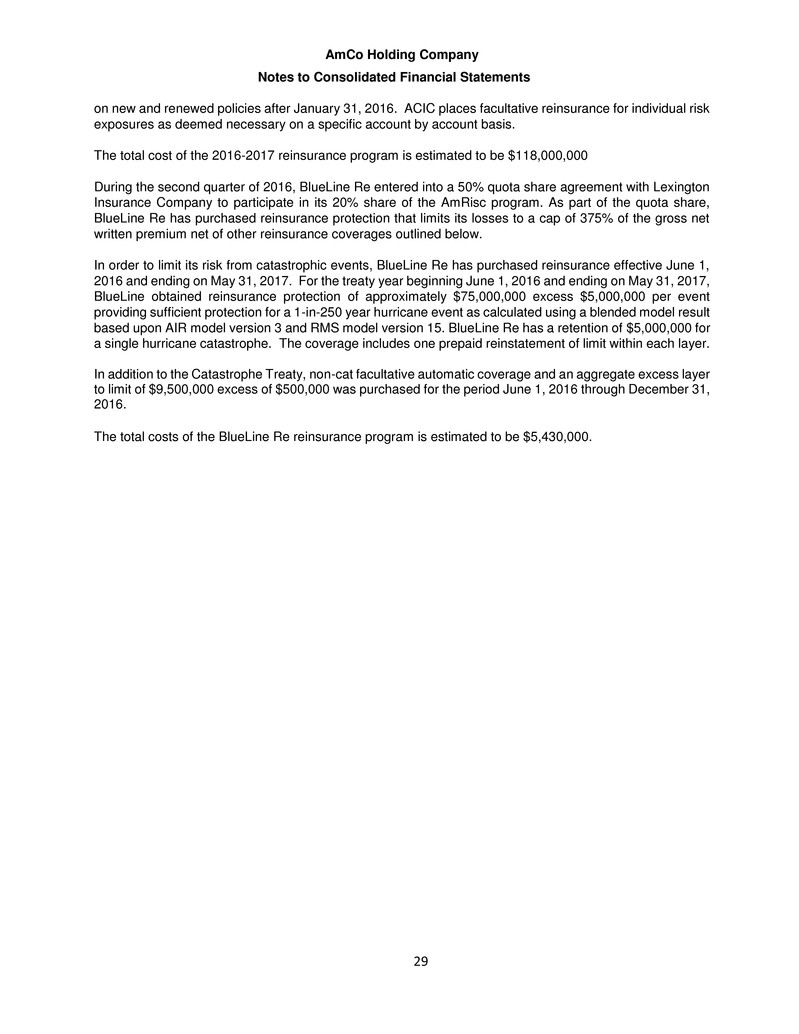
AmCo Holding Company Notes to Consolidated Financial Statements 29 on new and renewed policies after January 31, 2016. ACIC places facultative reinsurance for individual risk exposures as deemed necessary on a specific account by account basis. The total cost of the 2016-2017 reinsurance program is estimated to be $118,000,000 During the second quarter of 2016, BlueLine Re entered into a 50% quota share agreement with Lexington Insurance Company to participate in its 20% share of the AmRisc program. As part of the quota share, BlueLine Re has purchased reinsurance protection that limits its losses to a cap of 375% of the gross net written premium net of other reinsurance coverages outlined below. In order to limit its risk from catastrophic events, BlueLine Re has purchased reinsurance effective June 1, 2016 and ending on May 31, 2017. For the treaty year beginning June 1, 2016 and ending on May 31, 2017, BlueLine obtained reinsurance protection of approximately $75,000,000 excess $5,000,000 per event providing sufficient protection for a 1-in-250 year hurricane event as calculated using a blended model result based upon AIR model version 3 and RMS model version 15. BlueLine Re has a retention of $5,000,000 for a single hurricane catastrophe. The coverage includes one prepaid reinstatement of limit within each layer. In addition to the Catastrophe Treaty, non-cat facultative automatic coverage and an aggregate excess layer to limit of $9,500,000 excess of $500,000 was purchased for the period June 1, 2016 through December 31, 2016. The total costs of the BlueLine Re reinsurance program is estimated to be $5,430,000.
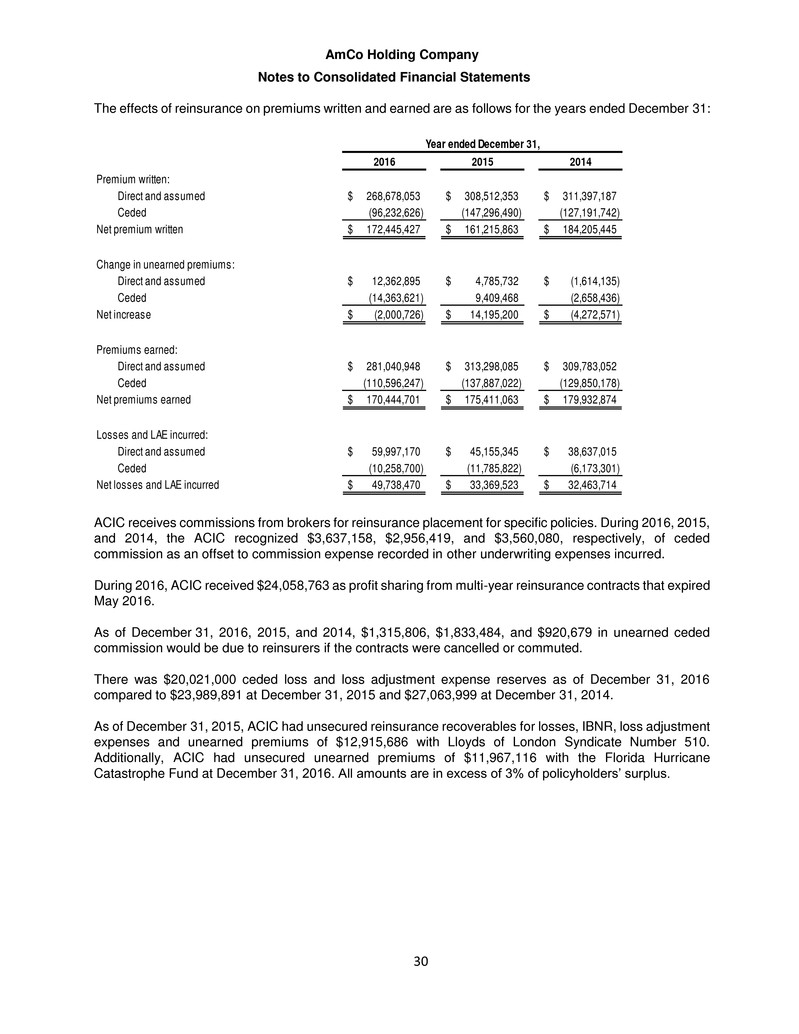
AmCo Holding Company Notes to Consolidated Financial Statements 30 The effects of reinsurance on premiums written and earned are as follows for the years ended December 31: 2016 2015 2014 Premium written: Direct and assumed 268,678,053$ 308,512,353$ 311,397,187$ Ceded (96,232,626) (147,296,490) (127,191,742) Net premium written 172,445,427$ 161,215,863$ 184,205,445$ Change in unearned premiums: Direct and assumed 12,362,895$ 4,785,732$ (1,614,135)$ Ceded (14,363,621) 9,409,468 (2,658,436) Net increase (2,000,726)$ 14,195,200$ (4,272,571)$ Premiums earned: Direct and assumed 281,040,948$ 313,298,085$ 309,783,052$ Ceded (110,596,247) (137,887,022) (129,850,178) Net premiums earned 170,444,701$ 175,411,063$ 179,932,874$ Losses and LAE incurred: Direct and assumed 59,997,170$ 45,155,345$ 38,637,015$ Ceded (10,258,700) (11,785,822) (6,173,301) Net losses and LAE incurred 49,738,470$ 33,369,523$ 32,463,714$ Year ended December 31, ACIC receives commissions from brokers for reinsurance placement for specific policies. During 2016, 2015, and 2014, the ACIC recognized $3,637,158, $2,956,419, and $3,560,080, respectively, of ceded commission as an offset to commission expense recorded in other underwriting expenses incurred. During 2016, ACIC received $24,058,763 as profit sharing from multi-year reinsurance contracts that expired May 2016. As of December 31, 2016, 2015, and 2014, $1,315,806, $1,833,484, and $920,679 in unearned ceded commission would be due to reinsurers if the contracts were cancelled or commuted. There was $20,021,000 ceded loss and loss adjustment expense reserves as of December 31, 2016 compared to $23,989,891 at December 31, 2015 and $27,063,999 at December 31, 2014. As of December 31, 2015, ACIC had unsecured reinsurance recoverables for losses, IBNR, loss adjustment expenses and unearned premiums of $12,915,686 with Lloyds of London Syndicate Number 510. Additionally, ACIC had unsecured unearned premiums of $11,967,116 with the Florida Hurricane Catastrophe Fund at December 31, 2016. All amounts are in excess of 3% of policyholders’ surplus.

AmCo Holding Company Notes to Consolidated Financial Statements 31 The following table highlights the effects that reinsurance transactions have on unpaid losses and loss adjustment expenses and unearned premiums in the Consolidated Balance Sheets: 2016 2015 2014 Unpaid losses and LAE: Direct and assumed 57,754,782$ 50,076,393$ 51,257,000$ Gross unpaid losses and LAE 57,754,782 50,076,393 51,257,000 Ceded (20,021,000) (23,989,891) (27,063,999) Net unp id l sse and LAE 37,733,782$ 26,086,502$ 24,193,001$ Unearned premiums: Direct and assumed 119,896,248$ 132,259,143$ 137,044,875$ Gross unearned premiums 119,896,248 132,259,143 137,044,875 Ceded (47,340,062) (61,703,683) (52,294,214) Net unearned premiums 72,556,186$ 70,555,460$ 84,750,661$ Year ended December 31, The Company’s reinsurance arrangements do not relieve the Company from its direct obligation to its insureds. The Company amortizes prepaid reinsurance premiums over the annual agreement period, and records that amortization in ceded premiums earned on our Consolidated Statements of Comprehensive Income. The table below summarizes the amounts of ceded premiums written under the various types of agreements, as well as the amortization of prepaid reinsurance premiums: 2016 2015 2014 ACIC Catastrophe Excess of loss 108,218,699$ 137,776,701$ 120,745,206$ ACIC Per Risk Excess of loss 6,642,584 9,519,789 6,446,536 ACIC Pr fit ha i g CAT XOL (24,058,763) - - Blue Line Re Catastrophe Excess of loss 5,096,394 - - Blue Line Re Per Risk Excess of loss 333,713 - - Ceded Premium Written 96,232,626$ 147,296,490$ 127,191,742$ Increase (Decrease) in ceded unearned premium 14,363,621 (9,409,468) 2,658,436 Ceded premium earned 110,596,247$ 137,887,022$ 129,850,178$ Years Ended December 31, 13. Leases In 2013, the Company entered into a sub-lease for office facilities from AmRisc for an initial term of one year through December 31, 2014. Following expiration of the initial term, unless the lease is otherwise terminated, the lease will automatically renew for consecutive one-year terms. The lease may be terminated with 90 days’ advance notice. The lease is subject to a maximum annual increase of 3%. The lease is assigned to AmRisc and the Company has a sublease with AmRisc for its office space. Total rental expense was $63,256, $40,585, and $37,997 for December 31, 2016, 2015, and 2014 respectively. Rental commitments under the lease are $65,154 for 2017.

AmCo Holding Company Notes to Consolidated Financial Statements 32 14. Other Contingencies and Other Commitments or Guarantees From time to time, the Company is subject to litigation arising in the ordinary course of business. The Company’s management believes that the resolution of those actions will not have a material effect on the Company’s financial position or results of operations. 15. Subsequent Events In preparation of the consolidated financial statements and related disclosures, the Company evaluated events and transactions subsequent to the balance sheet date through May 18, 2017, which is the date the consolidated financial statements were available to be issued. On August 17, 2016, the Company was a participant in an agreement with RDX Holding (RDX) and United Insurance Holding Company (UIHC) in which RDX will exchange its interest in Company for stock in UIHC. The Florida Office of Insurance Regulation provided consent to the transaction in January 2017 and UIHC shareholder approval of the transaction occurred in February 2017. The transaction was completed on April 3, 2017.

































